Geology As Hardened Biology
If Earth’s geology and landscape is mostly from the remains of Titans, then it should be possible to test whether this is true or false. Firstly, comparisons with human and animal anatomy should be possible. Secondly, geological processes that include petrification and fossilization are dependent on certain chemical reactions. The results will differ based on chemical compositions, including that of the agents of change. This should be verifiable. So, some knowledge of biology and chemistry is required to provide answers. For those who like to integrate information from as many sources as possible, esoteric knowledge concerning the creation of Earth is available. In this regard, the following YouTube videos are provided as starters for those with no background knowledge.

Click image for video link
Decayed Carcass Transitioned To Types Of Sandstones
YouTube, 14 Nov 2024
How did all this become a type of sandstone? This is absolutely not a sedimentary deposit with geological uplift. There are sedimentary deposits and I have shown them in videos, but this is not one of them..Most all of this is now sandstone, Why? Its transitioned to Course, Medium and Fine Sandstones. Why? There is no geological reason for this. The Kolbrin Bible states that earth’s land masses were raised up by carcasses that fell from the heavens and that is exactly what we are finding out.
Comment: There is a lot going on in this location! As you will see in the context of this webpage, geology can be demonstrated to be hardened biology.
Cape Arago Biology. Part 1
YouTube, 6 Jul 2023
If this is a Sedimentary deposit, then tell me what the sediment is? Its not vegetation or sediment from rivers of any kind!. No plants, no trees , no roots, no nothing that is in nature that would form sediment! Explain the sediment with evidence.?????This is not a sedimentary deposit with uplift. That theory is total nonsense!
Comment: This exploration is in 6 parts. Part 4 is drone footage.
The Formation of Earth & Ancient Text
Land Masses Built Up By Carcasses From Heavens. part 1
YouTube, 9 Jan 2025
This is not Lava and volcanic intrusions. Nothing about this is volcanic. It may look volcanic, but that is deceiving. Earth is not a creation of 5 billion years of evolutionary volcanism and geology. Humanity has been lied too.
Land Masses Built Up By Carcasses From Heavens. part 2
YouTube, 10 Jan 2025
Kolbrin Bible states that Earth land masses were built up by carcasses that fell from the heavens, and that is exactly what we see on Google Earth.
DESTRUCTION AND RECREATION OF EARTH.
YouTube, 1 Nov 2024
WHAT ARE THE CHANCES OF THIS??? Kolbrin bible speaks of earth’s destruction and recreation and the land masses being built up by dragons and creatures from heaven.. And that is exactly what we find and see. What are the chances of that???
Carcasses From "Chaos Deep" Formed The Worlds.
YouTube, 10th Feb 2024
Ancient text talk about 'chaos" before time began. I believe I have tied them together and we are here because of God forming all Worlds out of "CHAOS" Some form of creation that was here before our Earth and the other planets.
Comment: Well, I’m stunned.... I have been re-reading Delores Cannon and her The Convoluted Universe book series, which are the revelations of people under hypnosis. Some of the most advanced souls disclosed how they were involved in the creation of Earth, which matches what was written in the Kolbrin Bible. Life on Earth was built up slowly by literally bringing stuff to Earth and that includes all sorts of creatures....
The Fortean Connection
For serious researchers and possibly the odd academic, please note the works of Charles Fort (1874 – 1932) in documenting 'skyfalls'. Not only was the creation of this planet created by a delivery mechanism of titan carcasses, in the present day there is an apparent maintenance system in place. Hence, when stocks run low of any particular creature, there are 'skyfalls'. As some kind of 'proof' I would suggest reading The Complete Works of Charles Fort. These are the books; THE BOOK OF THE DAMNED, NEW LANDS, LO! & WILD TALENTS. When using an internet archive .pdf copy of
The Complete Works of Charles Fort
(4 books in 1), a search of the word 'fall' was found 1,207 times. From the introduction we read:
“Charles Fort sat at a table in the New York Public Library or the British Museum every working day for twenty-seven years, reading and rereading the back files of every available scientific journal, popular science magazine and newspaper. When he found something out of the ordinary and not conventionally explainable, he made a note of it. Eventually he had thousands of these notes, written on little slips of paper, filed in shoeboxes.
He found that sober and experienced observers, again and again, had reported falls of blood, of fish, of frogs; had seen unknown bodies in the heavens and unknown objects flying overhead. Long before they were called “UFOs,” Fort listed sightings of oddities in the sky from as far back as 1779.”
Charles liked to lampoon officialdom when they tried to make excuses for these skyfalls and the example given in the introduction is of a fishmonger who decided to throw his product away, “tons upon acres” in the form of crabs and periwinkles. To my knowledge, this herculean research effort has never been repeated in history. However William R Corliss (1926 - 2011) is considered a direct successor of Charles Fort with his books related to anomalous phenomena. In acknowledgement of these great works by Charles Fort, the Fortean Society was created in 1931 to promote the ideas of Charles Fort, but was never formally dissolved when the leader died. According to @Grok, other offshoots still exist today in one form or another Link.
|
Salt Mines Or Inside Petrified Titan Flesh?
There are vast caverns of petrified Titan flesh inside planet Earth. Do the following images prove it?
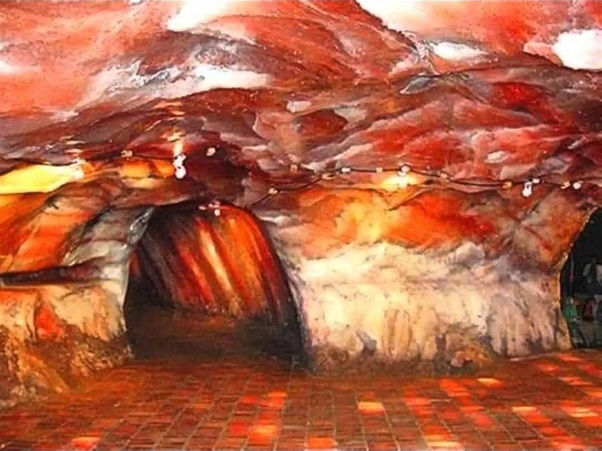
Walkway with lights. Khewra Salt Mine, Pakistan.
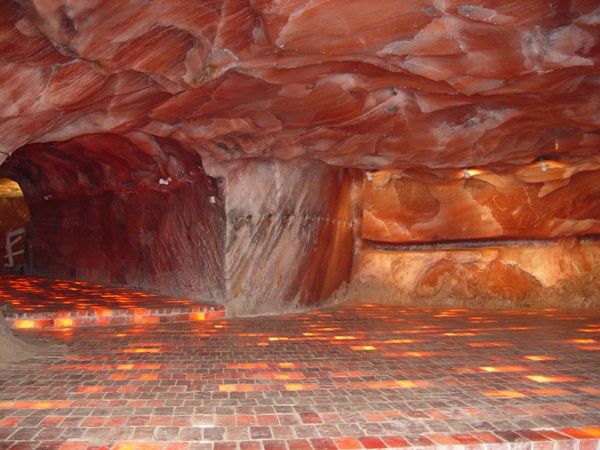
Walkway with lights. Khewra Salt Mine, Pakistan.
Click image for link
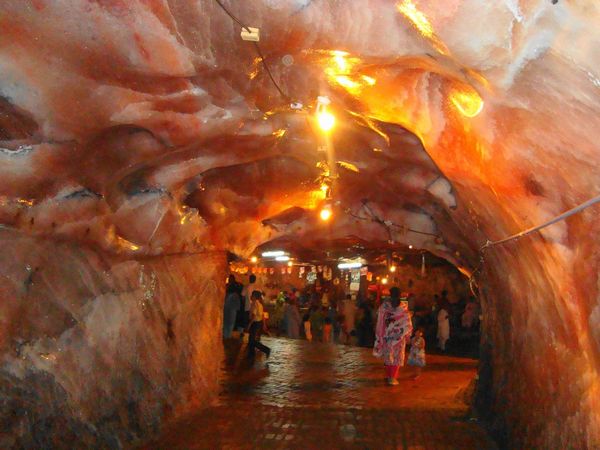
Reception. Khewra Salt Mine, Pakistan.
Click image for link
Comment: The Khewra salt mine in Pakistan, is home to the brand name only Himalayan Pink Salt products. Obviously, the bricks are made from the petrified flesh.
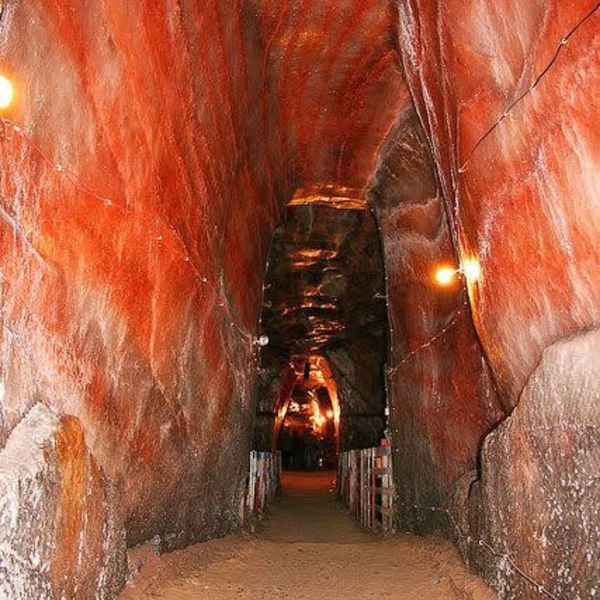
Walkway with lights. Khewra Salt Mine, Pakistan
Click image for link
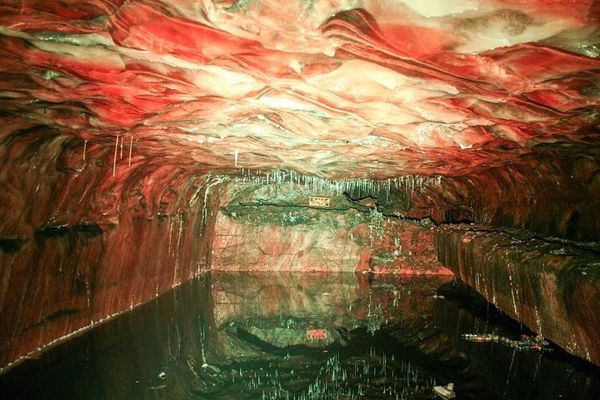
Click image for link
Himalayan/Khewra Rock salt has a beautiful texture and color which ranges from off-white to deep pink. This salt is the purest form of salt in the world and is harvested by hand.
Comment: This caption is ridiculous, does that look like quality to you? This meaty cavern has got too much water in it and the ‘meat’ rock has turned green, just like mouldy meat turns green.
Inside the salt mine so large it has a mosque and electric railway and where tourists can follow in footsteps of Alexander the Great
• World’s second largest salt mine has 18 working levels and 40 kilometres of tunnels
• Salt mine in Pakistan boasts a mosque made from salt, an electric train and an asthma clinic offering salt therapies
• Mine history dates back to 320 BC, following its discovery by Alexander the Great’s troops
Daily Mail, 22 April 2013
The Khewra salt mine, the second largest in the world, is a warren of 40 kilometers of tunnels housing an illuminated mosque made from salt rock, an electric train and even an asthma clinic.
The mine 100 miles south of Pakistan’s capital Islamabad is the largest and oldest salt mine in the country, drawing up to 250,000 visitors a year.
Comment: This article forgets to mention that the mining is actually deep inside the mountains of Pakistan.
|
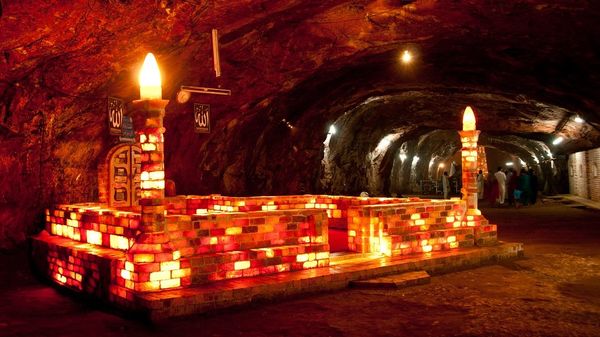
Mosque inside Khewra Salt Mine
Click image for link
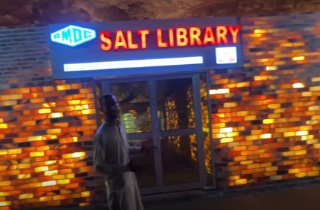
Salt Library. Khewra Salt Mine
Click image for video link (Timestamp)
How They Mine Tons of Himalayan Salt Deep Inside Mountain | Himalayan Salt Mining | Pink Salt Mine
YouTube, 3 Jul 2024
Comment: In Hindi only but the video of conditions inside the mine is excellent. The existence of the salt library with books on display is ineteresting! Nobody looks cold and the conditions must be generally dry.
|
|
Inside the Second Largest Salt Mine in the World 🧂
YouTube, 7 Jul 2021
I head 1 km inside Pakistan’s largest Himayalan salt mine! This is Khewra Salt Mine and it’s located in Jhelum District, Punjab. Today it’s a major tourist attraction drawing up to 250,000 visitors a year.
The mine is famous for its production of pink Khewra salt, often marketed as Himalayan salt, and is a major tourist attraction. The mine is also known as Mayo Salt Mine. [...]
Comment: Inside the mine seems to vary in terms of meat rock and salt rock. The question is: Was this one petrified Titan or a group of petrified Titans.... Another questions is: why is this pink salt found so high inside mountains?
|
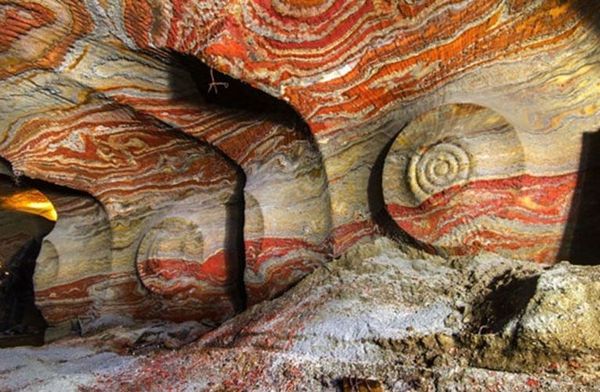
Psychedelic cave near Yekaterinburg, Russia
Click image for link
Abandoned mines near Yekaterinburg, Russia
keramogranit.ru
These psychedelic salt caves are covered in layers of carnallite, a mineral used in fertilizer production. Only a small portion of the mines remain operational, and most are now closed to the public.
Salt mine in Russia.
It’s like walking inside something that was once alive. | XTwitter video Link
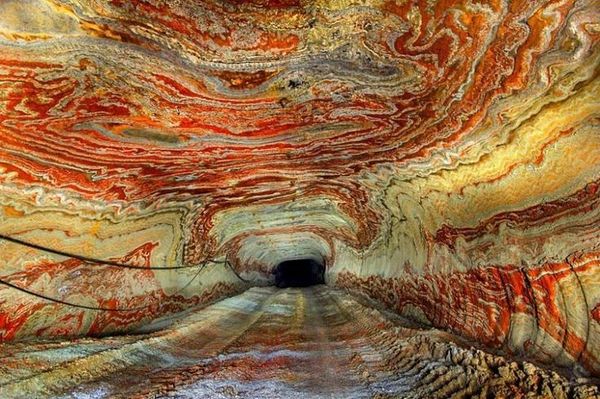
Psychedelic cave near Yekaterinburg, Russia
Click image for link
Abandoned mines near Yekaterinburg, Russia
keramogranit.ru
These psychedelic salt caves are covered in layers of carnallite, a mineral used in fertilizer production. Only a small portion of the mines remain operational, and most are now closed to the public.
Salt mine in Russia.
It’s like walking inside something that was once alive. | XTwitter video Link
Psychedelic cave near Yekaterinburg
Forbes, 21st June 2014
These patterns seem to have some kind of extraterrestrial origin, but in fact, this amazing and colorful salt cave is located under Yekaterinburg. The walls of the abandoned salt mine are covered with psychedelic patterns, “painted” by layers of carnallite, a mineral used in the production of fertilizers. It is usually yellow, white or reddish, but sometimes blue or even colorless carnallite is found. Several mines for the extraction of this mineral continue to function, but most of the corridors and passages are now closed, and you can only get there with special government permission.
Comment: Note the mineral carnallite. Carne is Spanish or Italian for “meat” and comes from the Latin carnis meaning “flesh.” It’s not a coincidence. There are actually 11 photos here.
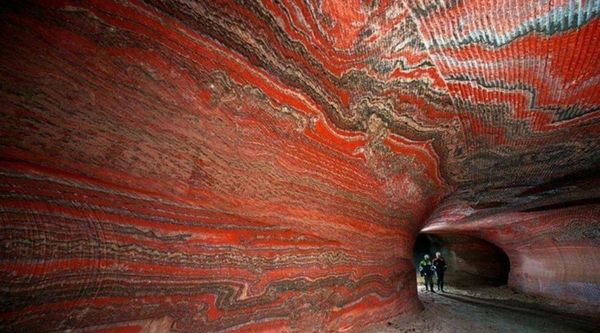
Psychedelic cave near Yekaterinburg, Russia
Click image for link
Salt Mine Mystery Discussed
YouTube, 8 Oct 2018
Dazzling colors in this Russian salt mine...but why? How can these patterns and amazing contrasting bands of color be explained?
MUDFOSSIL EYES explain the unexplained....solve the unsolved and tell the truth we have so long been denied.
Comment: In the intro, Roger Spurr says this is meat! He explains where the wavy dark lines come from in the meat walls and the difference with the connective tissue that forms the roof of this cavern. At 3:30 he compares pork ribs to the 2nd walkway with lights image from the Khewra Salt Mine, Pakistan. Then he explains how this Titan flesh turned to salt. He says the salt comes from being close to a kidney that has leaked it’s natrium or natron (sodium and potassium mixture) which acts as a preservative.
Comment: Follow the link here for the original Facebook source. Also: similar images on X.com Link
The Realmonte Salt Mine in Sicily
Amusing Planet, Nov 26, 2015
In the southern cost of Sicily, the largest island in the Mediterranean Sea, lies the town of Realmonte where there is a huge underground salt mine with tunnels that goes on for 25 km some 100 meters below the ground. The walls of the salt mine are naturally adorned with alternating bands of dark and light colored rocks arranged in concentric circles and stripes.
Comment: The patterns here are striking... Seriously, how do geologists explain them? The colouring makes it less obvious that it’s flesh.
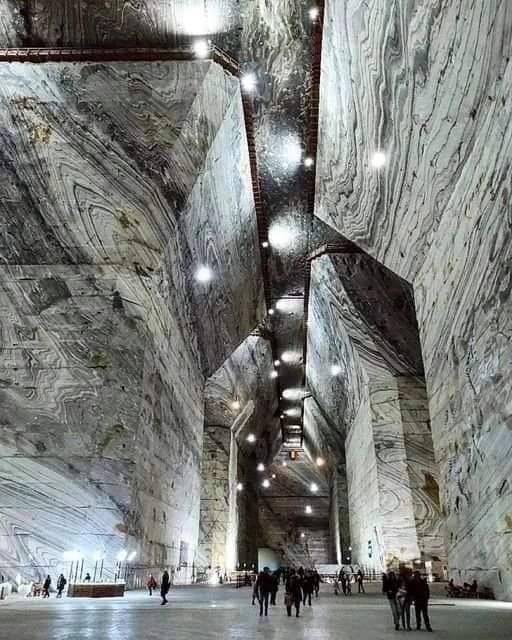
The old Slănic salt mine in Prahova county, Romania.
Click image for link
Comment: If you follow the links, it seems to be some kind of tradition to turn some of the bigger caverns into churches and cathedrals.
The Petra Meat Feast
The UNESCO World Heritage Site known as Petra is one of the New 7 Wonders of the World and famous for being an ancient city carved out of red sandstone rocks in Jordan. Tourists are informed that the grandeur of this place is about the stunning architecture combining Hellenistic elements with traditional Nabataean rock-hewn tombs and temples. Furthermore, there is a rich history spanning from prehistoric times to the 12th century. Then for some reason, Petra disappeared from people’s memory until it was rediscovered in the 19th century. Yet, when watching the video Petra, Jordan [Amazing Places 4K] the travel blogger complained that Petra was a city that is about 7 miles long, but most tourists only go the the Treasury, take their photos and leave. Hence, it was with some surprise that I discovered that Petra is actually quite a meat feast as the following images will demonstrate. However, as a previso it must be understood that something is going on with colour saturation and it has been noted in other interesting locations too. If the image colours are out, it’s difficult to see see any patterns in the rock, but if you up the colour enhancement, it becomes a wonder to behold.
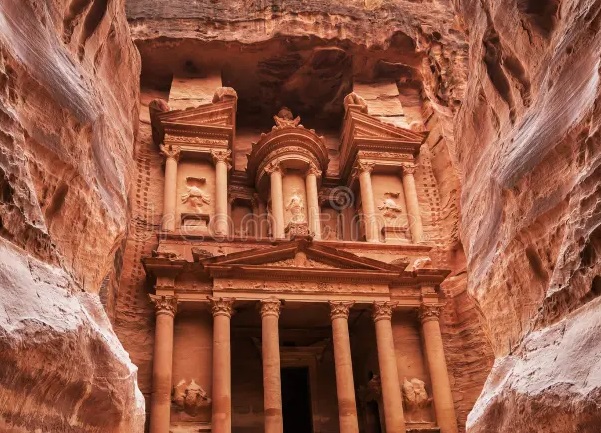
View of Al Khazneh, the Treasury. Petra in Jordan.
Click image for link
Carved monument in red canyon rocks. Popular landmark in the Middle East. Narrow gorge in the Siq ends at Petra`s most elaborate ruin, Al Khazneh.
Aerial views slowly approaching Treasury, Petra - HD stock video
Getty images
Sequence of drone shots slowly approaching the Treasury, also known as Al-Khazneh, through gaps in tall rock at the ancient site of Petra in Jordan. (Core number: FKIC696E. ABTA682A)
Comment: This Getty drone video is actually quite dramatic..... More Getty videos
here.
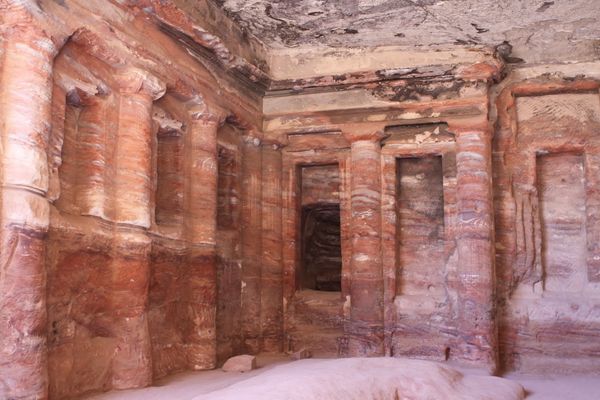
Al Khazneh at Petra The Palace Tomb
Click image for link
Al Khazneh (The Treasury) is one of the most elaborate temples in the ancient city of Petra. The structure is carved out of the sandstone rock face of the cliff. It has classical Greek influenced architecture. Originally built as a mausoleum and crypt in the early 1st century AD. Featured in Indiana Jones and the Last Crusade.
Comment: Actually it’s ridiculous, there are websites selling pictures with pictures of 2 different buildings called The Treasury! Anyway, I think this building and maybe others have been cemented over to hide the original rock formation, which can be clearly seen inside the tombs and caves. Please note the collection of hi-res close-up images of the exterior and interior rooms here.

Treasury Tomb main room. Petra.
Click image for link
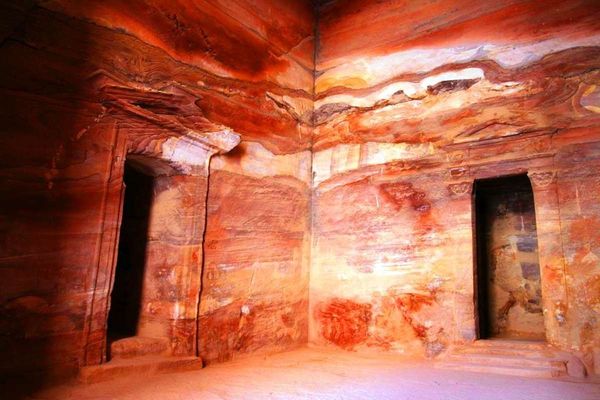
Treasury Tomb main room. Petra.
Click image for link
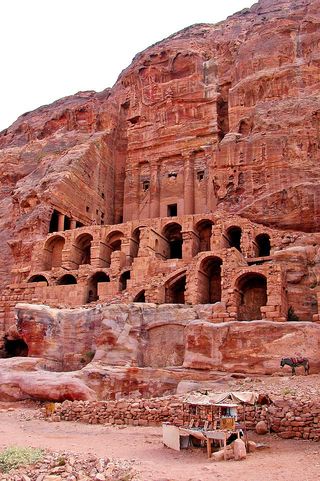
The Urn Tomb exterior. Petra.
Click image for link
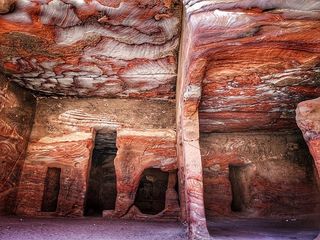
The Urn Tomb interior. Petra.
Click image for link
The Urn Tomb is among the most distinctive of the Royal Tombs of Petra, recognized by the enormous urn on top of its pediment. The tomb has a two-story substructure of arched vaults and a large colonnaded courtyard, offering a spectacular view over the city.
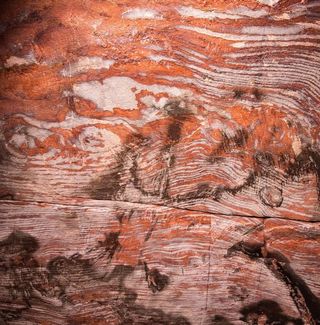
Click image for link
Urn Tomb interior wall, Petra, Southern Jordan
|

Silk Tomb, Petra.
Click image for link
The rich colour of sandstone is said to be changing during the day!
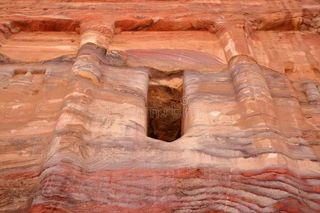
Silk Tomb exterior close-up. Petra.
Click image for link
The Silk Tomb is a smaller tomb next to the Urn Tomb. This name comes from the rich color of the sandstone.
Comment: Summary Royal Tombs Petra
Scholars disagree with the name “Treasury,” pointing out that the “Treasury” is actually a ceremonial tomb. It is a royal burial place, or royal mausoleum, built in the 1st century BC, which serves as a memorial for members of the royal family. It is likely the tomb of a Nabatean king (al-Harith IV), as confirmed by excavations carried out by the Jordan Antiquities Authority.
Archaeologists have been taught to call buildings they don't know what they are, tombs or temples.
Kaunos Royal Tombs, Dalyan, Türkiye 🇹🇷 | XTwitter video Link
Comment: Very similar to Petra, but on the side of a mountain!
|

Unknown Tomb or cave. Petra.
Click image for link
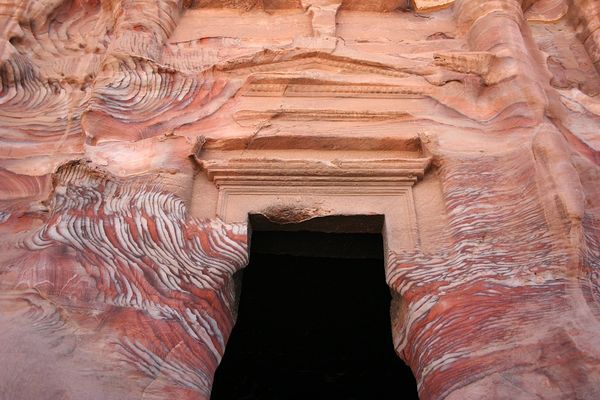
Tomb of Sextius Florentinus, Petra.
Click image for link
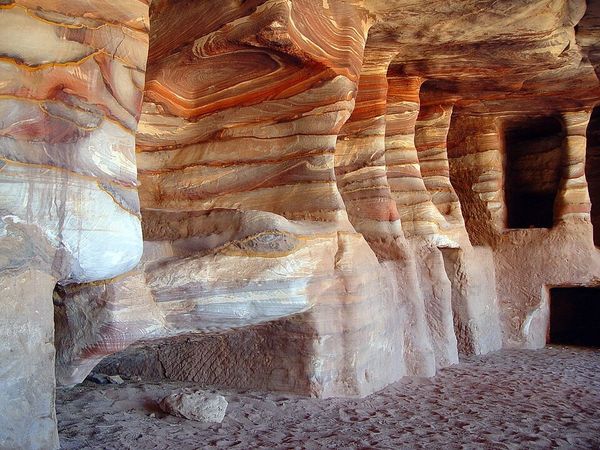
Kokh-type tombs cut into the multicoloured sandstone of Petra
Click image for link
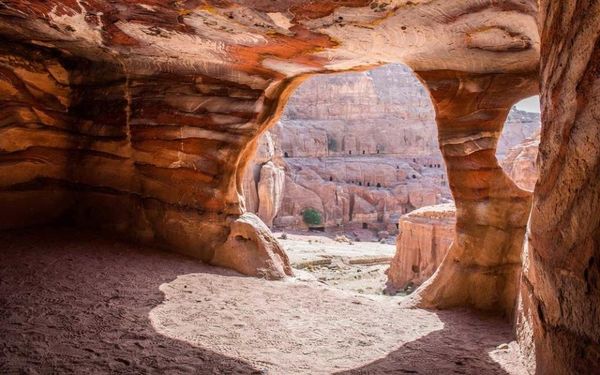
Zebra Cave View, Petra.
Click image for video link
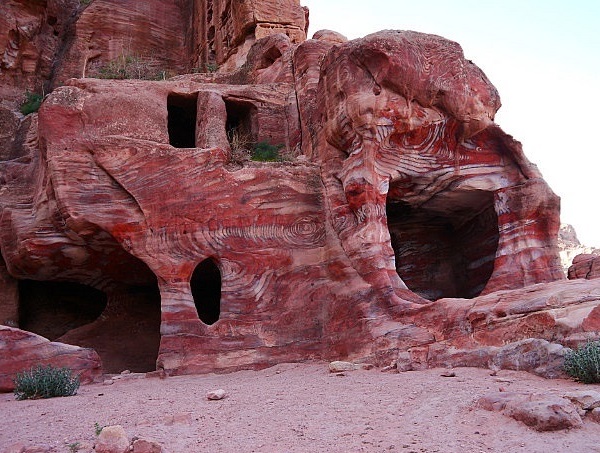
Coloured cave exterior, Petra.
Click image for link
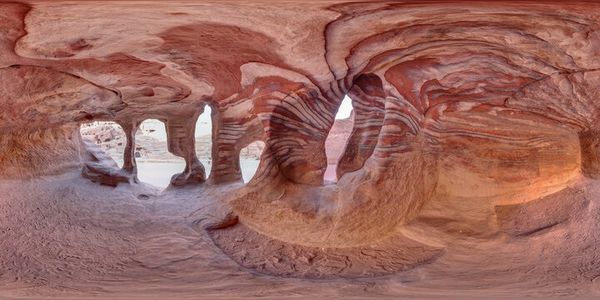
Coloured (meat) cave interior, Petra.
Click image for link
Petra, Jordan [Amazing Places 4K]
YouTube, 2 Jun 2017
Comment: Timestamp. Cave interiors start at ~4 minutes. See write-up for more timestamps.
Biology at Petra not missed By Mudfossil University [3:48]
YouTube, 30 Nov 2021
Tell me what you see once you see what you see. You might be...... Petrified
Comment: Roger Spurr says we are seeing giant dermal layers of tissue not sedimentalogy laid down over millions of years and states, Petra is made from 100% blood and flesh! In this presentation, Roger starts off by showing relaxed and contracted muscle. He then shows the famous Petra Treasury with the adjoining rock clearly revealing the striation of muscle! See for yourself.
Comment: Also Timestamp: Mudfosology Explains Exactly How Petra and the Grand Canyon Formed
The real meaning behind PETRA in Jordan
YouTube, 7 Apr 2024
Comment: Btw, there are people claiming that Petra was carved directly from the wood of a giant tree, now petrified. Also: Part 2 . The rebuttal to that is that there is no explanation for the rock formation patterns and the colour of the rocks. However, we do have instances of salt mines with very similar rock formation patterns, see more examples online from the abandoned salt mine near Yekaterinburg, Russia. Even the fleshy tones don’t come across as the remains of a silicon or carbon based tree. Maybe this is an instance of having a hammer and everything is then seen as a nail.
Muscle Matters On A Titanic Scale
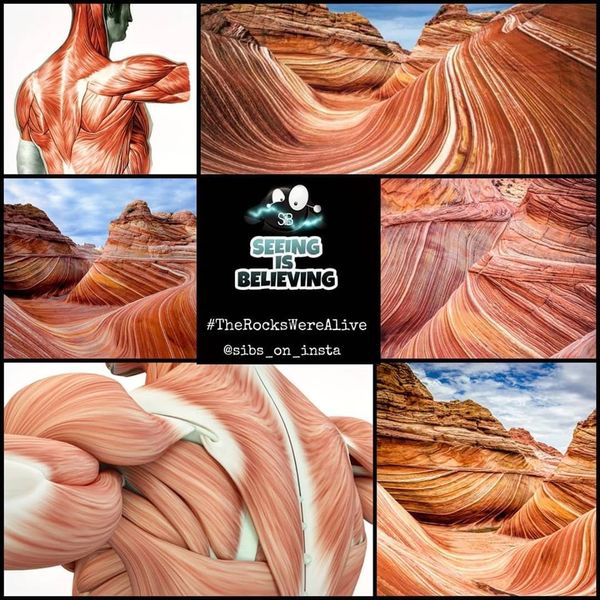
“The Wave” - a sandstone erosion pattern in Arizona compared to human muscles Link.
Click image for link
Comment: Also see the muscle layout associated with tennis elbow Link
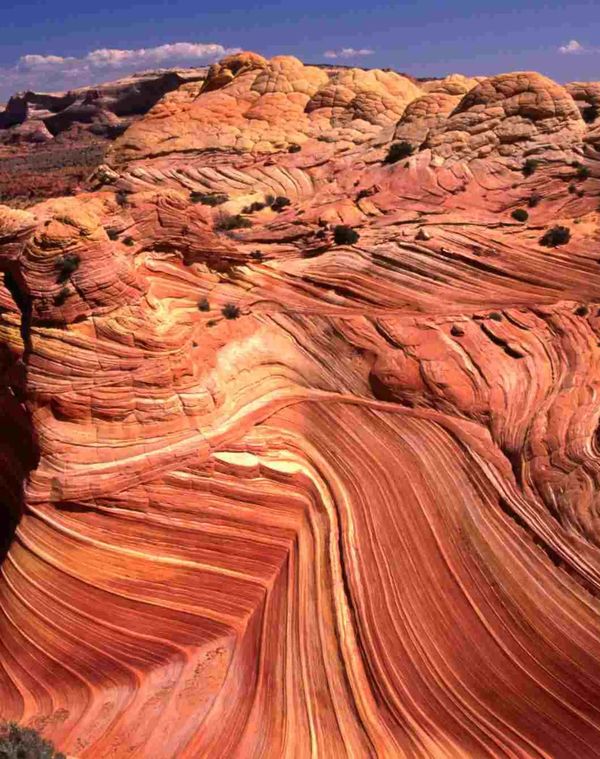
Near the city of Fruita, Colorado National Monument
Click image for link
Comment: We don’t just have muscles on display here, if you look carefully (top) you can also see what looks like large intestine membrane, just like at White Pocket, Arizona. See more below as explained by Roger Spurr. (Yes, I initially thought it was skin, but have been educated.... Link)
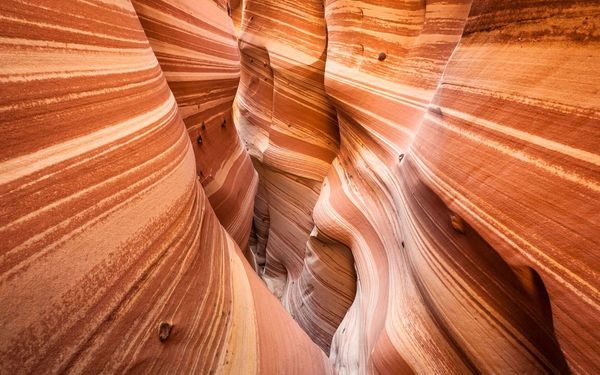
Zebra Canyon, Utah
Click image for link
This hidden gem can be found in the Grand Staircase-Escalante National Monument, Utah.
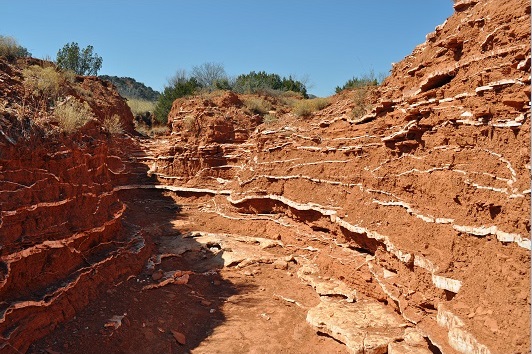
Caprock Canyons, Texas
Click image for link
Layers of gypsum in a creek bed, North Canyon Loop Trail, Caprock Canyons State Park, Quitaque, Texas.
|
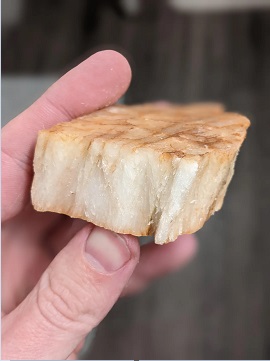
A piece of gypsum
Click image for link
Comment: Found some discussion about the geology at Caprock Canyons at Reddit Link. This close-up image of a piece of gypsum makes the case that this was originally a piece of fat before it turned into rock! What’s more, if you do a search on gypsum layers in rock, the results will also show gypsum in veins of rock that overall looks like marbled meat....
|
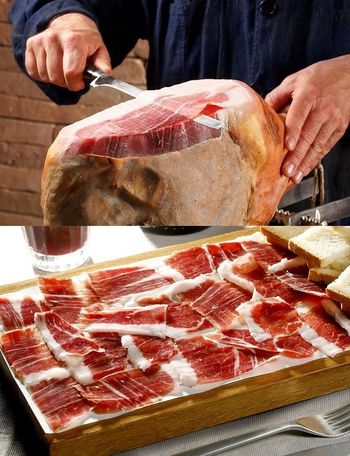
“Prosciutto Crudo di Parma” or Parma Ham
Click image for link
Meat is primarily skeletal muscle tissue and the distribution of meat to layers of fat is dependent on the location in the creature’s body. Therefore, we are seeing some high quality meat here!
|
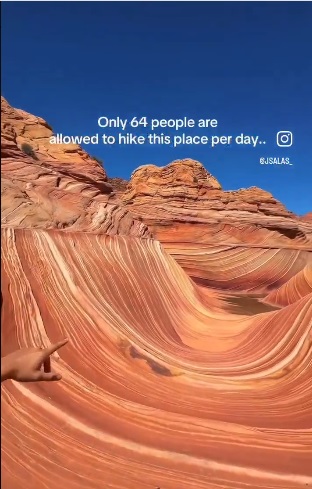
Click image for video link
The Wave in Arizona, a stunning sandstone wonder in the Paria Canyon-Vermilion Cliffs Wilderness, boasts vibrant, wind-carved stripes. Near the Utah border, it’s a 6-mile hike from Wire Pass Trailhead, requiring a permit via a competitive lottery.
|
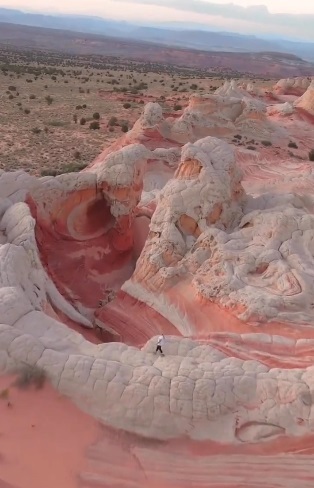
Click image for video link
White Pocket, Arizona has a marvelous geology, very likely result of a big sand-slide mass, set off by an earthquake which created deformations and fluid formations
Comment: Quite frankly, this looks very fleshy. Note the comment in the thread re Baconland!
|
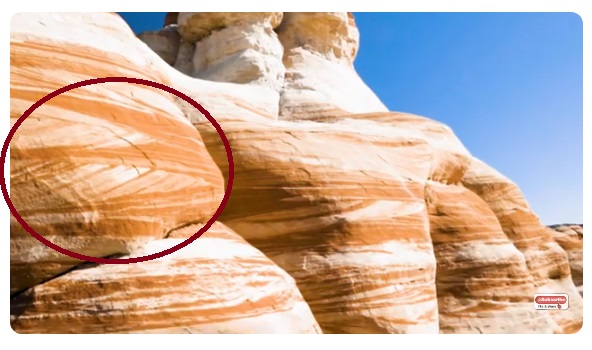
Blue Canyon, Arizona
Click image for video link (timestamp)
Blue Canyon, Arizona - Hopi Guided Tour - One of the most beautiful canyons in Arizona
YouTube, 5 Nov 2019
Blue Canyon is a lesser known but incredibly scenic canyon in Arizona. It is located on the Hopi Reservation, near Tuba City. A Hopi guide is required.
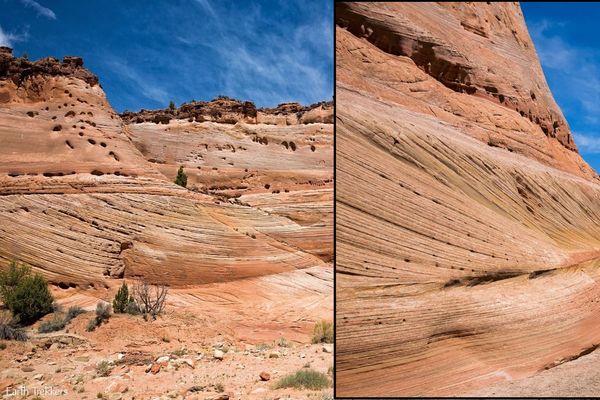
Red rock detail at Zebra Slot Canyon Trail, Arizona.
Click image for link
The trailhead is located on Hole-in-the-Rock Road in Grand Staircase-Escalante National Monument, Arizona.
Comment: Note the herringbow cross stratification on the red rock formations (left).Click link for more original earthtrekkers.com images.

Herringbone cross-stratification
Click image for link
Comment: This is how conventional geologists explain this enigma.
What would a Geologist Call this [1:33]
YouTube, 23rd Nov 2020
Comment: Roger Spurr explains that we are seeing muscles hardened into rock.

Fire Wave rock formation in Valley of Fire State Park, Nevada
Click image for link
Comment: Also similar image on X.com Link
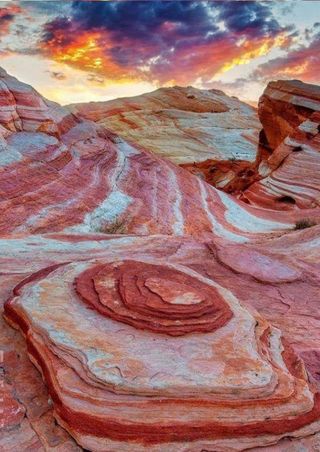
Valley Of Fire State Park, Nevada
Click image for link
About Valley of Fire [VIDEO]
Nevada State Parks.
World-renowned for its 40,000 acres of bright red Aztec sandstone outcrops nestled in gray and tan limestone, Valley of Fire State Park contains ancient, petrified trees and petroglyphs dating back more than 2,000 years.
Comment: Parts are very similar to the meat caves in Petra, Jordan and The Wave in Arizona, United States etc.
|
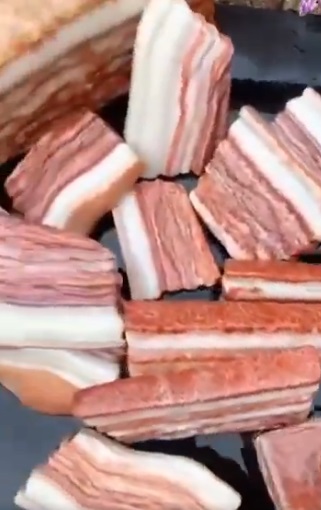
Cutting Bacon Rock
Click image for video link
Comment: First the video starts off by showing a normal looking rock (~1 metre wide by 1/2 metre high by 1/2 metre long) being cut to show the bacon texture inside. Next the video shows small handsized pieces to be sold to tourists.
|

Rhodochrosite or meat rock.
Click image for link
Rhodochrosite is a manganese carbonate mineral with chemical composition MnCO3. In its (rare) pure form, it is typically a rose-red color, but impure specimens can be shades of pink to pale brown.
|
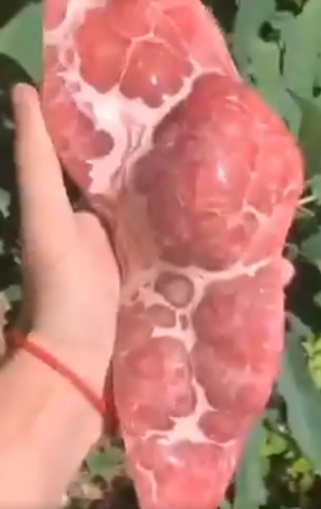
Rhodochrosite or meat rock
Click image for video link
They say this is Rhodochrosite a rare mineral of group V (carbonates), according to the Strunz classification🤔
Comment: Meat rock. ‘Rhodo’ and ‘Rhod’ are the Latin root words for rose or rose-colored.
|

Uncooked bacon rock
Click image for link
Comment: Is this dark red stone jasper?

Raw Red Jasper Agate Rough Stone
Click image for link
Comment: This looks like raw red meat....
|
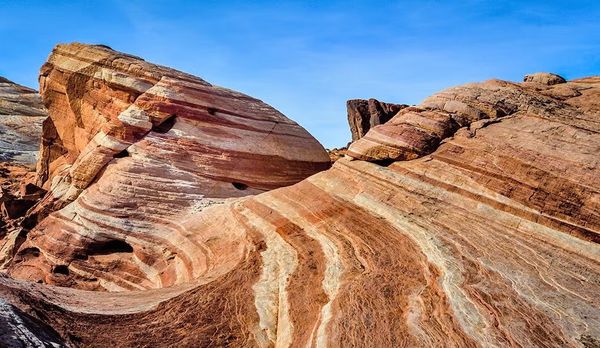
Rock formation, Valley of Fire, Nevada.
Click image for link
Yale to rename Geology & Geophysics department
Yale News, Feb 10, 2020
Yale University said Feb. 10 that its Department of Geology & Geophysics will change its name to the Department of Earth and Planetary Sciences to better reflect the breadth of faculty research and teaching and Yale’s deep engagement in the most important questions about planet Earth today. [...]
Yale scientists are also studying biogeochemical cycles that govern the coevolution of Earth’s surface and life forms, and helping us understand the rise of microbial and animal life in conjunction with major climatic or extinction events.
Comment: Hmmmm.... I thought Roger Spurr was making things up when he suggested that Yale were catching on and slowly making changes to their curriculum based on his research. However, after reading this article, I think he might be right! I think the real obvious nod is the use of this particular Valley of Fire, Nevada rock formation.... Presumably, too many people agree with the Mudfossil hypothesis and they don’t want to be seen being left behind.... Watch the Mudfossil University video below.
Did Yale Drop the Name Geology in Favor of Planetary Science Which is the Mudfossils I Showed Yale
YouTube, 4 Jul 2025
We have missed much about our Earth. I reported my research to Yale...Derek Briggs.....he then wrote about “Exceptional Soft Tissue Preservation” taking credit for my research and they renamed Geology because it is HARD BIOLOGY.
It is not understood until you understand Mudfossils and the evidence in chemistry and anatomy and stories told in Every Culture on Earth...lets think this thru shall we?
Comment: I am very proud of Roger Spurr, he has 228,000 followers on YouTube! The top academics must be worried!
The Petrified Forest National Park In The Cross Hairs
The Petrified Forest National Park is a national park of the United States in northeastern Arizona. The park is named by the large deposits of petrified wood, and covers about 346 square miles (900 square kilometers). It encompasses semi-desert shrub steppe as well as highly eroded and colorful badlands. Since
images from the Petrified Forest have already been featured in the Rainbow Mountains section, the focus here is what is going on with the petrified “tree logs”. The first observation to note, is that there are no obvious tree stumps of any size in this region, just petrified “tree logs” lying around, mostly of the same widths and lengths. Furthermore, there are long logs that have remained in tact, yet they show evidence of section “joints,” Well, maybe there is an explanation, but it is certainly not conventional.
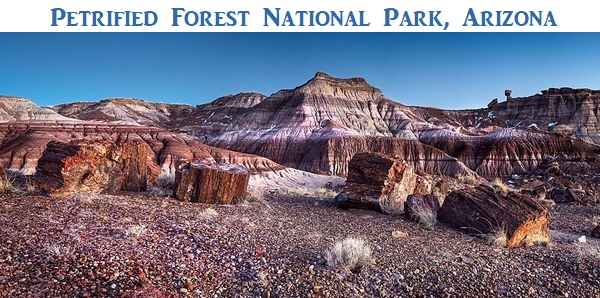
Jasper Forest in the Petrified Forest National Park in Arizona.
Click image for link
Petrified Forest National Park in Arizona is divided into several main areas, each with distinct features. Jasper Forest is known for dense petrified wood deposits scattered across rolling hills.
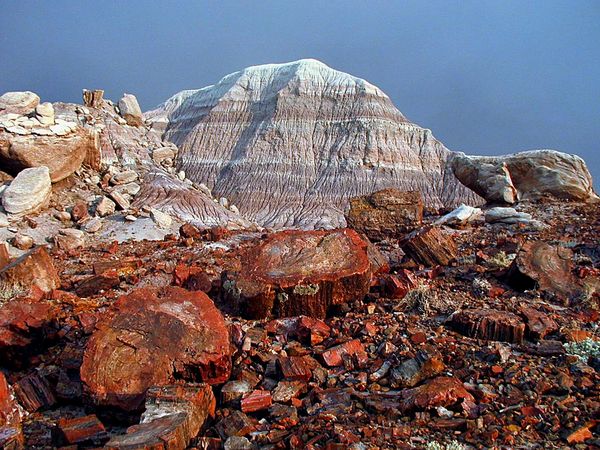
The Rainbow Forest in the Petrified Forest National Park.
Click image for link
Home to large concentrations of colourful petrified logs, including the Giant Logs and Long Logs trails.
Trip Adviser Photos: Link
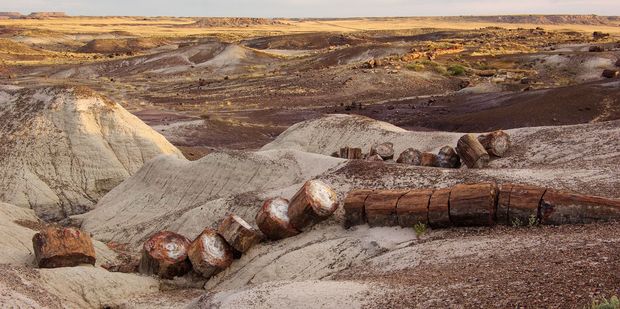
Crystal Forest, Petrified Forest National Park
Click image for link
Named for the sparkling quartz crystals once found in petrified logs (now mostly removed by early visitors). Grok brief details of other areas Link
Photo Gallery: Petrified Forest in Arizona
Daryo, 19th Nov 2018
In the US state of Arizona, there is a forest remnant whose trees glow in rainbow colors in the sun. The national park, called the “Petrified Forest,” is made up of tree trunks and trunks that have turned into various minerals. The area, which was a dense forest 200 million years ago, turned into a desert as a result of climatic and geographical changes.

A “tree log” up close revealing opal, a semi-precious stone
Click image for link

A “tree log” up close revealing opal, a semi-precious stone
Click image for link
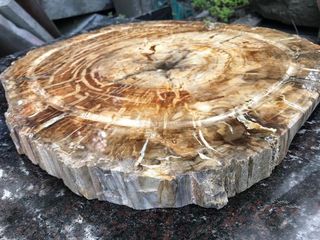
A Petrified Wood Tray
Comment: This is petrified wood, not what can be seen in the Petrified Forest.
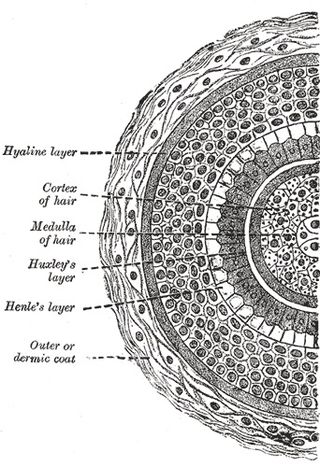
Human Hair Cross-section
Click image for link
|
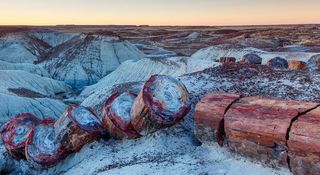
A “tree log” has broken apart and partially turned into opal, a semi-precious stone
Click image for link
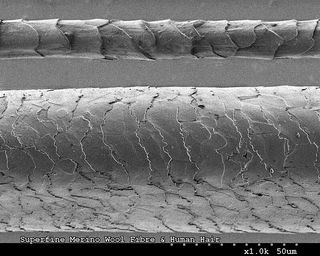
Top: Superfine Merino wool fibre
Bottom: Human hair cross-section
Click image for link
A scanning electron microscope image showing the difference in size and texture between a superfine Merino wool fibre (top) and a human hair (bottom)
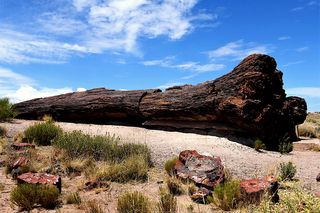
A “tree log” with a bulbous end
Click image for link
Also another close-up showing section “joints” Link

Section of skin, showing the epidermis and dermis; a hair in its follicle; the Arrector pili muscle; sebaceous glands.
Click image for link
Comment: Maybe, it’s a titan hair instead! Once you’ve done enough research, you can recognise a petrified titan hair anywhere in the world! See mini-slideshow for Druzhkovka Petrified Trees in Ukraine
Link.
|
These Look Like Petrified Tree Sections But it is Not From a Tree Here is Why I Claim That
YouTube, 4 Jun 2025
We all hear about Petrified Wood but from my research that would be a very rare case. Wood did not survive well in the great flood but these things that Look Like wood did survive...but it was not from trees.
Comment: I first saw a video where Roger Spurr agreed that the Petrified Forest had the remains of petrified chopped up trees, but he claimed that they had absorbed blood which turned the wood into semi precious stones. However, he has since re-thought this and now claims these are giant (Titan) hairs and he shows why they fragmented into blocks using the anatomy of hair. Looking at the evidence it becomes hard to dismiss the hypothesis.
Also: Lets talk about Petrified trees [...]
|
Devil’s Corkscrews & Other Devils
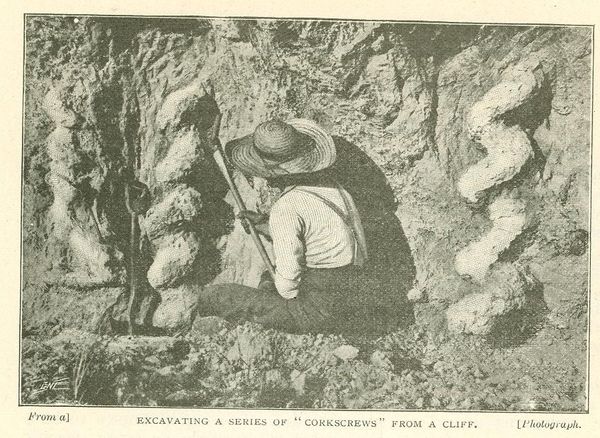
Excavating a series of corkscrews from a cliff
Click image for video link
The Devil’s Corkscrews
Amusing Planet, Sep 5 2017
In the mid-1800s, ranchers across Sioux County, in the US state of Nebraska, began unearthing strange, spiral structures of hardened rock-like material sticking vertically out of the ground. The spirals were as thick as an arm and some of them were taller than a man. Not knowing what they were, the ranchers began calling them “devil’s corkscrew.”
The puzzling structures first came to the notice of the scientific community through geologists Dr. E. H. Barbour in 1891, when he was asked to investigate a nine-foot long specimen that a local rancher had discovered on his property along the Niobrara River. Barbour found that the spirals were actually sand-filled tubes with the outer walls made of some white fibrous material. Barbour knew they were fossils but of what he wasn’t sure. He named them Daemonelix, which was just the Latin equivalent of its local name, devil’s corkscrew.
Comment: This article has more historic photos. The following annotated diagrams provide a far more compelling explanation for these mysterious rock spirals and associated tubes found closeby.
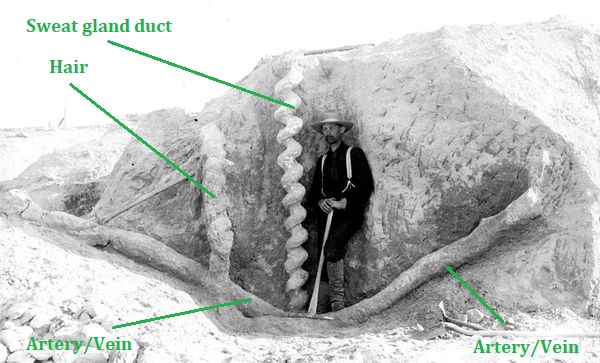
Daemonelix burrows from the Miocene at Agate Fossil Beds National Monument, Nebraska.
Click edited image for link
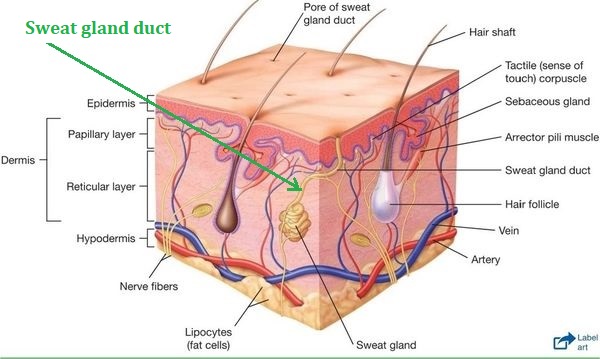
Integumentary System. Sweat Gland Duct
Click edited image for link
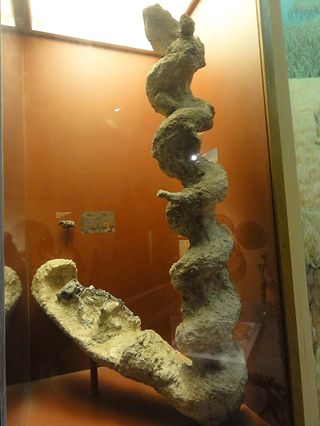
Palaeocastor(Daemonelix) and burrow in National Museum of Natural History.
Click image for link
|
A fossilized burrow known as a “devil’s corkscrew” created by the extinct beaver Palaeocastor.
YouTube, 25 June 2025
Comment: I can only assume that this YouTube short was created in response to Roger Spurr mocking the ridiculous explanation for the existence of the rock spirals. What’s even more ridiculous is the remains of a beaver added in the museum for good measure to make the story more believable!
Why in 2025 are people defending old and obviously banal made-up stories? It’s a fact, we are living in more enlightened times! Btw, I really don’t believe the YouTube viewing numbers either, those were obviously paid for....
|
Devils Corkscrew Mystery Finally Solved (Mudfossil Sweat Glands) What Do You Think Please Comment
YouTube, 18 Jun 2025
Comment: Roger explains that these corkscrews are titan sized sweat gland ducts and hence are often found with hairs and powdery clay soil which was the original epidermis skin layer. Now, if the creature did not sweat, then you will find evidence of titan hairs, but without the sweat glands. Stone Columns, Crowley Lake, California, USA | Timestamp
Link
Please note that when there is a major geological anomaly or a place that authorities wants to keep the populace away from, it is designated as belonging to the Devil. Presumably, this was popular at a time when the masses were very religious and readily brainwashed. Anyway, here are more examples:
Devil’s Marbles – Australia (big round rocks)
Devil’s Causeway (Giants Causeway) – Antrim, Northern Ireland (crystalline structures)
Devil’s Pool – Victoria Falls
Death Valley National Park
Devil’s Staircase – a path through the Aonach Eagach ridge in Scotland
Devil’s Staircase – a section of state Highway 6 in Otago, New Zealand
Devil’s Staircase Wilderness – nature reserve – Oregon
Devil’s Rock – (Made famous in the movie – Close Encounters of the third kind) (crystalline structure)
Devil’s Tower – Gibraltar (Ancient Watchtower)
Devil’s Gate 220 – Indian reserve in Alberta, Canada
Devil’s Lake – Michigan
Devil’s Den State Park – Arkansaw (crystalline structures)
Devil’s Slide is the name of several geological formations
Devil’s Chimney – rock formation- Gloucestershire.
Devil’s Chimney – rock cleft – Isle of Wight
Devil’s Chimney – former rock formation – Beachy Head
Devil’s Thumb – Greenland
Devil’s Highway (Nickname) – Route 666 (US 666). With the 666 designation.
Source: A flat fact Live
Titan Hairs At Crowley Lake
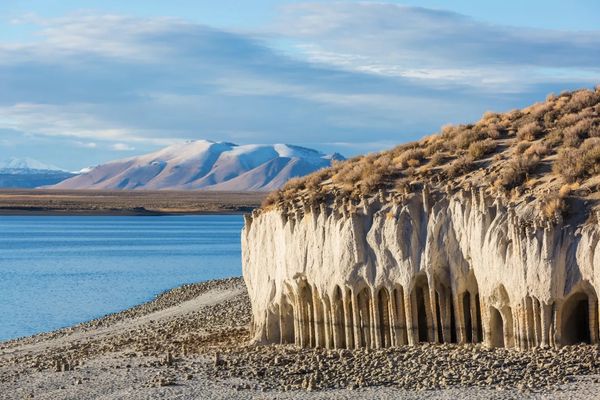
Stone Columns, Crowley Lake, California, USA.
Click image for link

Stone Columns, Crowley Lake, California, USA.
Click image for link
|
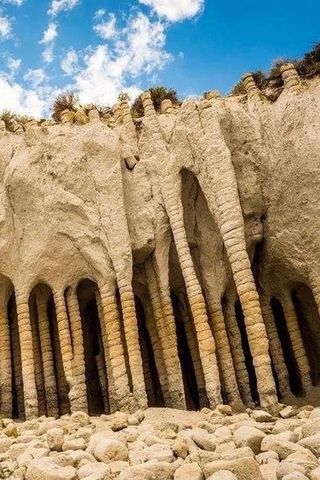
Stone Columns, Crowley Lake, California, USA.
Click image for link
Comment: Titan Hair! Note the columns poke out of the powdery (kaolin clay?) soil which was originally skin.
|
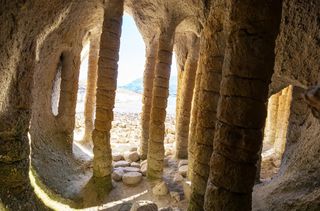
Stone Columns, Crowley Lake, California, USA.
Click image for link
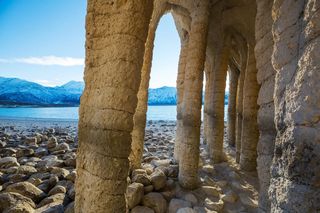
Stone Columns, Crowley Lake, California, USA.
Click image for link
|
Explore Crowley Lake Columns: California’s Most Distinctive Rock Formations
unusualplaces.org
After Crowley Lake was first created in Mono County, California in 1941 due to the construction of the Long Valley Dam, onlookers noticed some striking rock formations along the eastern shore that looked like spindly columns. At first glance, casual observers wondered if they had stumbled upon an ancient temple that had been lost in the sands of time. Geologists ultimately determined that the rounded columns were crafted entirely by nature due to a volcanic eruption that took place over 700,000 years ago.
Comment: After a while, the pure speculation and no proof is just funny....

Titan hair follicles. Sunset Bay (North of Cape Arago), Oregon.
Click image for video link (Timestamp)

Titan hair follicle. Sunset Bay (North of Cape Arago), Oregon.
Click image for video link (Timestamp)
Decayed Remains of a Titan with hair follicles..100% Biological
YouTube, 23 Feb 2020
These are the remains of a Mudfossilized Leviathan Creature of which the Earth is formed out of. You are looking at layers of tissues of skin, interstition fabric, hair follicles and base layer skin....

Click image for link
How does a tree grow through millions of years of sediment?
Comment: Well, it’s not a tree and sediment did not get laid down over millions of years....
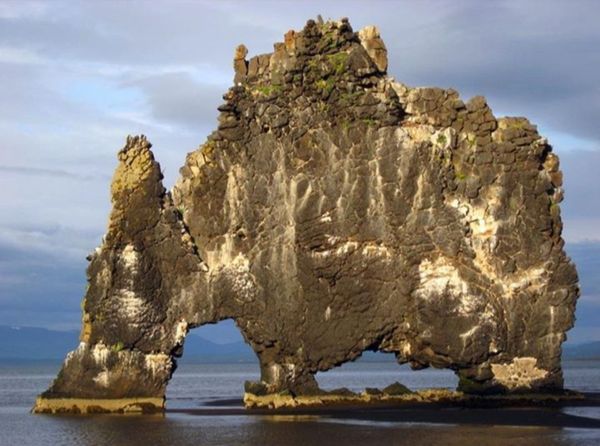
HVITSERKUR Rock Formation, Iceland
Click image for link
Comment: I thought this 50ft basalt stack was some kind of creature.... Roger says it’s the remains of a wart on some hairs.... So I have renamed it Devil’s Wart! LOL Here is another view Link. Seriously, if this was a huge wart on a Titan compared to a human today, my calculation is that the Titan was 2.1 miles (3.5km) high.... Actually, Roger Spurr quotes the Book of Enoch that states the giants (Titans) were 2.5 miles high and his research agrees. So, I am rather pleased with my conservative estimate based on this Devil’s wart....
Skin & Bones on a Titanic Scale
On a titanic scale, the discussion of skin would seem very strange. Often there is no evidence left of outer skin as it has been washed away. Sometimes skin is compressed, it looks like the layers and layers that geologists tell us were laid down over millions of years. Sometimes skin has turned to powder and today we mine it as Kaolin or another trade name for fine clay. Well preserved fossils of outer skin have been found, World’s oldest skin preserved in extraordinarily rare fossil find, but often what we see on the surface and think is probably titan skin, is actually a highly textured membrane from deep inside the body.
Since there are a lot of bones in any body, this section will mostly offer examples that commonly are found, but are still considered an enigma. In this regard, checking for sources to verify images has been time consuming. I would have liked to have included The Forbidden Dragon’s Spine. Kunlun Mountains, China, link. But after going through 13 pages of Alamy images from the region, I had to conclude it was a fake. So this section will not be exhaustive, but hopefully there will be updates in the future.
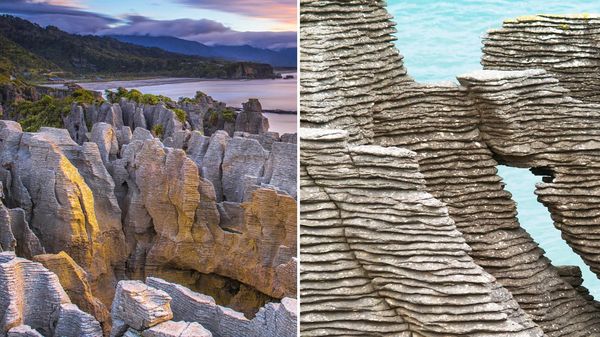
Pancake Rocks, New Zealand
Click image for link
Witness The Mysterious Beauty Of The Pancake Rocks In New Zealand
The Pancake Rocks in New Zealand are an extremely popular tourist attraction on the West Coast and is a must-see for those travelling along the coast
Travel + Lesisure, Jun 26, 2019
Strange but beautiful, the Pancake Rocks are an extremely popular tourist attraction on the West Coast of New Zealand. This is a must-see sight for those travelling along the coast.
Layered like giant stacks of pancakes, this heavily eroded limestone area is on Dolomite Point, near Punakaiki, a village on the South Island of New Zealand, between Westport and Greymouth. The foundations of these rocks were formed 30 million years ago, with dead marine creatures and plants landing on the seabed, and then being subjected to immense pressure from the water. This caused them to solidify into alternating hard and soft layers of limestone.

Kaolin Mining Quarry in Wrens, Georgia, US
Click image for link
|
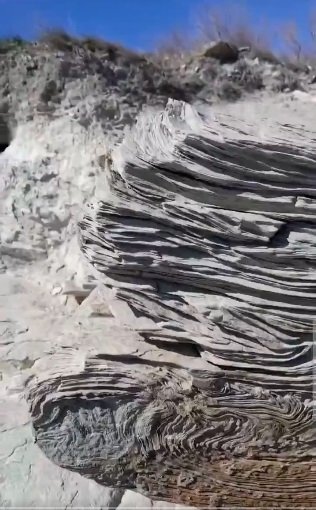
Click image for video link
Comment: Layered rock on display demonstrating titan sized petrified skin.
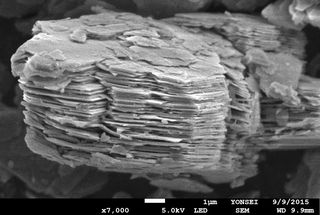
Layered structure of the clay mineral kaolinite under an electron microscope. (Compressed titan skin tissue).
Click image for link
Mica Kaolin and Mud are Body Tissue Membranes
YouTube, 15 Aug 2022
What you will see is the source of Mica and its origin.
This is an untold story with history and misery.
Comment: As usual we have a meandering introduction here. In another video RS shows us a paper that claims that MICA represents the layers of thin surface skin. Kaolin clay and all the other MICA molecules are in the skin and surface flesh Link. Roger Spurr also provides a video clip of childen being forced to mine kaolin.
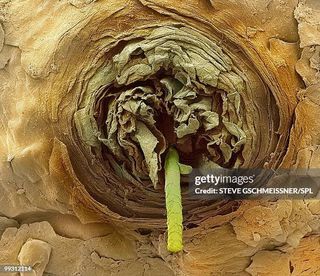
Eyelash follicle, SEM
Click image for link
Eyelash follicle, colored scanning electron micrograph (SEM). Magnification: x400 when printed at 10 centimeters wide.
|

Kaolin clay colours
Click image for link
Kaolin clay or Kaolinite, is a naturally occurring silicate mineral and is one of the most abundant clay minerals on earth.
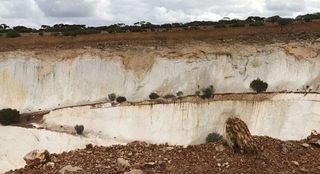
Exposed white kaolinte in the pit wall at the Mt Gibson Wombat Gold Project in the Yilgarn Craton of Western Australia.
Click image for link
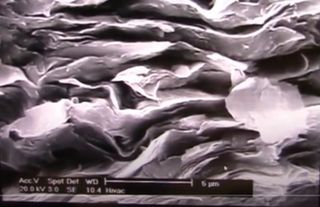
Layers of skin under an electron microscope
Click image for video link, (Timestamp)
Comment: Uncompressed human skin under an electron microscope. Just to get the right perspective. @Grok states 20-50% of household dust is dead skin cells, even though the common myth is the percentage is much higher.

Click image for video link
Spectacular Sunset over the Sorting Hat / Witch’s Hat (Harry Potter)
This exotic sandstone rock formation is located in South Coyote Buttes, Vermillion Cliffs National Monument, Arizona, USA
Comment: These thin layers of rock are previous layers of a titan creature’s epidermis, easily understood with the Mudfossil hypothesis.
|
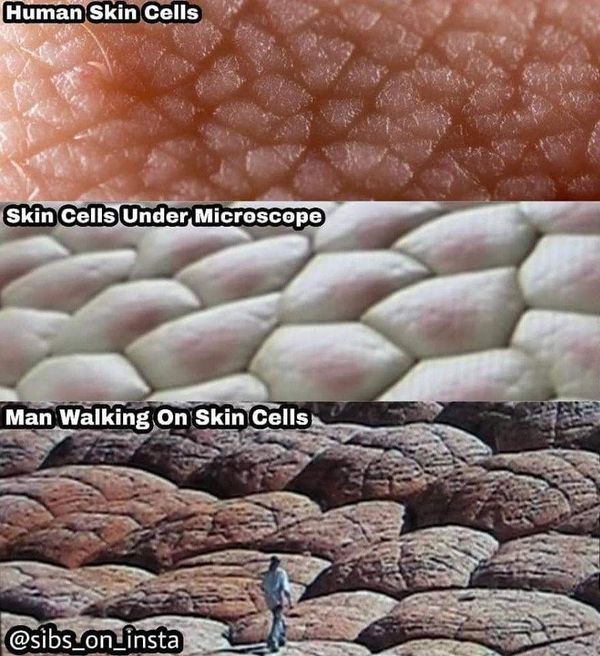
Click image for video link
Comment: RS discusses skin cells at different scales. This is most likely stomach lining see more below. Timestamp
link

The Devil’s Slide: A massive-size limestone chute in Utah’s Weber Canyon
Click image for link
Comment: There are 8 historic photos of Devil’s slide here.
|

Devil’s slide is a National Historic monument in Utah
Click image for link
Devil’s Slide is actually just two large layers of limestone. Each formation is approximately 40-feet tall, and the two formations are approximately 20-feet apart.
Comment: A few historic photos and info here.
|

Click image for video link
Can An Expert Geologist Please Explain the True Origin of this Devils Slide Formation in Utah USA
YouTube, 17 Aug 2025
Comment: Roger Spurr explains this strange geological formation as titan sized biolipid layer membranes that we often see flat. In this case, the geological feature is upright and due to erosion appears like a chute.
@Grok states; In summary, biolipid layer membranes are ubiquitous in human and animal bodies, forming the structural basis of all cell and organelle membranes, as well as specialized structures like the myelin sheath. They are critical for compartmentalization, protection, and biochemical processes. Link .
|
Dem bones, dem bones

Geologic boudinage or evidence of ribs?
Click image for link
Basically, titan petrified bones are hard to find because they were mostly dissolved in salt during the major worldwide flood described in ancient text. This is explained by Roger Spurr in the video Giant Flood Giant Brains and body parts but Few Bones Why. RS also makes the point that the medical community have made the link between a high salt diet and osteoporosis i.e. weak bones. Whatever, there is one location I have found that I think might prove to be an exception and provide worthy examples of titan bone remains.

World Cup Rock formation in Sahara desert, Tassili N’Ajjer National Park, Tadrart Rouge, Algeria [North Africa]
Click image for link
Comment: The best bit is the bone surrounded by muscle sticking out the top...
|

The World Cup Rock formation in Sahara desert, Tassili N’Ajjer National Park, Tadrart Rouge, Algeria [North Africa]
Click image for video link (Timestamp)
Mysterious Geology vs Biology vs Anomalies Seen thru the Latest Soft Tissue Fossil Research
YouTube, 21 Nov 2024
Comment: RS briefly explains why he thinks this is the remains of a giant foot. Accordng to @Grok the “World Cup Rock,” does not have a well-documented previous name and is likely named because due its shape resembles a trophy or cup
Link.
Personally, I find this quite unbelievable. I was thinking this formation had been renamed because it’s the remains of a giant foot. This would have been a funny joke for those in the know, as it’s similar to golden boot trophies handed out at football World Cups....
|
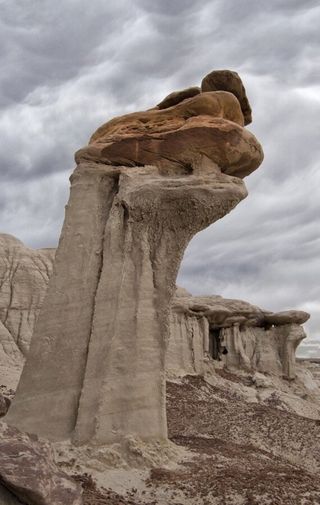
Ah-Shi-Sle-Pah Wilderness Study Area
San Juan Basin of northwest New Mexico
Click image for link
|

Ah-Shi-Sle-Pah Wilderness Study Area
San Juan Basin of northwest New Mexico
Click image for link
|
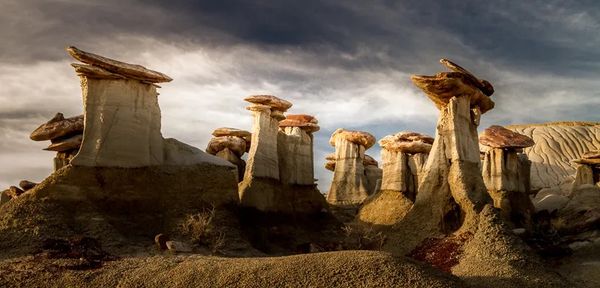
Ah-Shi-Sle-Pah Wilderness Study Area
San Juan Basin of northwest New Mexico
Click image for link
|
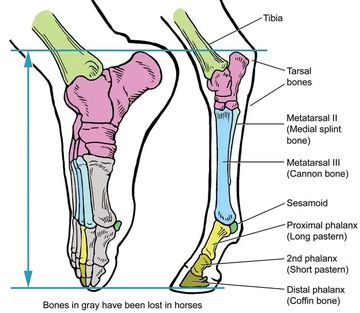
Equine Hock Joint
Click image for link
Comment: I think the above images are eroded bones and associated joints. After some consideration, I think the top left image is clearly a bone and that it could be similar to an equine hock joint. A biologist would need to confirm whether this is an accurate assessment.
|
Ah-Shi-Sle-Pah Wilderness Study Area
Atlas Obscura
The land is full of geologic eye candy, such as otherworldly spires, mushroom-shaped hoodoos, and prehistoric fossils.
With its muted colors and striking geology, this unusual landscape feels like a martian planet. Pale, mushroom-shaped hoodoos loom above the rocky earth like enormous alien trees. Petrified tree stumps and ancient bones speckle the badlands like prehistoric markers of its long-gone inhabitants.
Comment: Interestingly, the bones are not pointed out in the Atlas Obscura slideshow. However, maybe, the truth is in plain sight.
|

Spinal vertebrae at the Towering Tumulous Complex in the Pipestone Megacomplex
Click image for link
|
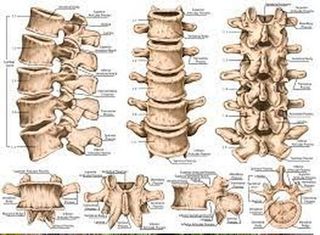
Spinal vertebrae anatomy
Click image for link
|
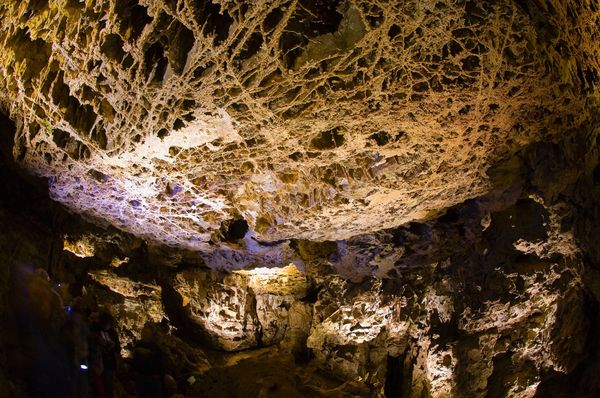
Wind Cave National Park, South Dakota.
Wind Cave National Park is a national park of the United States located 10 miles (16 km) north of the town of Hot Springs in western South Dakota.
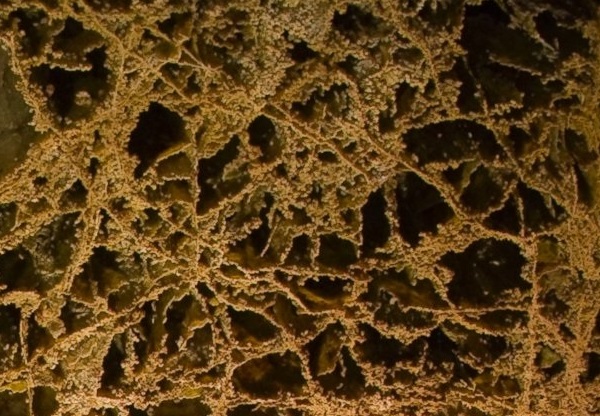
Close-up of cave ceiling. Wind Cave National Park, South Dakota.
Click image for link
Boxwork or a honeycomb pattern, is seen here on the ceiling of Wind Cave National Park, South Dakota.
Comment: I truly think this is one of the best examples of cancellous bone tissue you will find, due to this ceiling being inside a cave and not exposed to the elements.
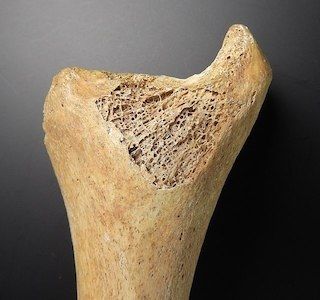
Click image for link
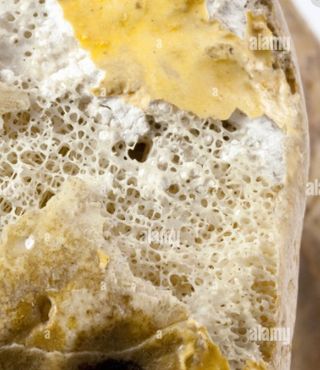
Human femur bone, close-up
Click image for link
Close up, far end of a human femur bone to show the internal cancellous or trabecular, spongy bone
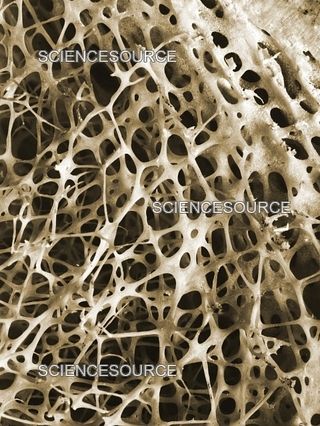
Shin bone, SEM.
Click image for link
Scanning electron micrograph (SEM) of cancellous (spongy) bone of the human shin. Bone tissue is either compact or cancellous. Compact bone usually makes up the exterior of the bone, while cancellous bone is found in the interior. Cancellous bone is characterised by a honeycomb arrangement of trabeculae. These structures help to provide support and strength. The spaces within this tissue normally contain bone marrow, a blood forming substance.
|
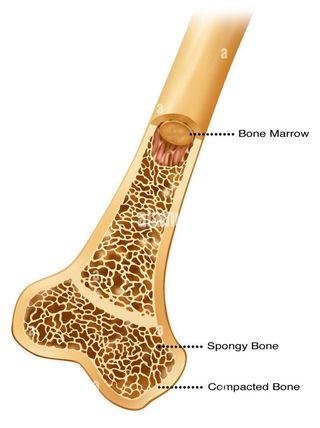
Click image for link
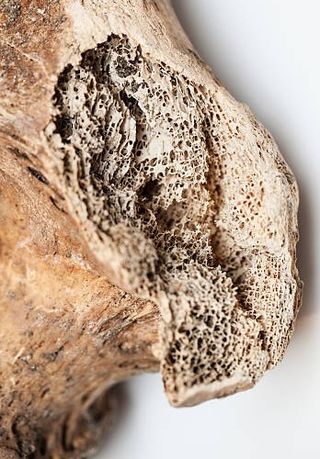
Click image for link
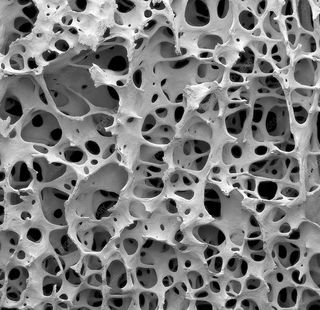
Bone tissue, SEM
Click image for link
Bone tissue. Scanning electron micrograph (SEM) of cancellous (spongy) bone. Bone tissue can be either cortical (compact) or cancellous. Cortical bone usually makes up the exterior of the bone, while cancellous bone is found in the interior. Cancellous bone is characterised by a honeycomb arrangement, comprising a network of trabeculae (rod-shaped tissue). These structures provide support and strength to the bone.
|
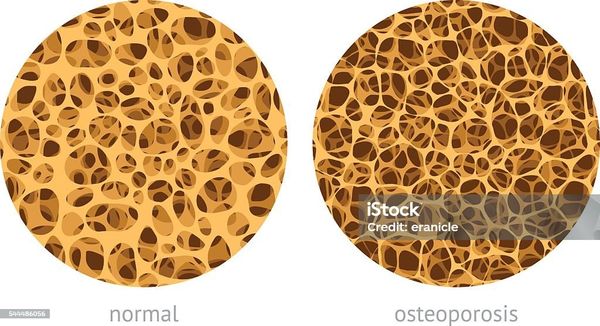
Bone spongy structure. Normal vs Osteoporosis
Comment: Just to add to the complexity. However, I presume this image is AI generated and therefore could be misleading.
|
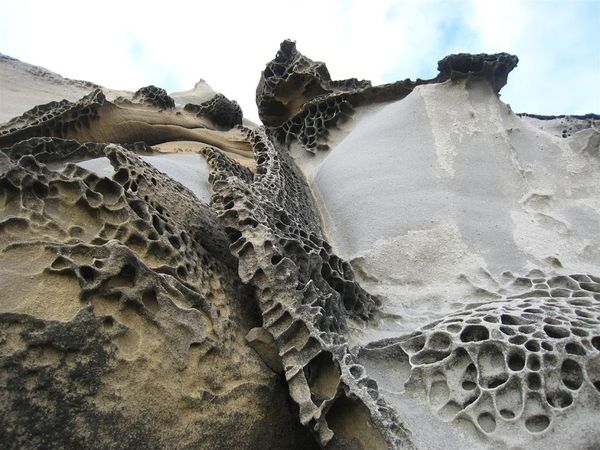
Unusual rock formations. South of Stump Beach at Salt Point State Park.
Click image for link
Moon Rocks and a few other oddities at Salt Point Park as photographed by John Sperry
Mendonoma Sightings, March 2, 2013
[...] They are calleded Moon Rocks because of their many craters. These are sedimentary sandstone formations. They actually continue underwater and provide valuable habitat for marine life. Above the sea, salt crystals are found in the cracks and crevices, which are called tafoni. Kasaya Pomo collected salt there for many years, using abalone shells as chisels. This is how this land came be to named Salt Point.
Comment: Obviously, these hikers have been at a loss as to how to understand this rock formation. The Mudfossil explanation that this is the remains of a Titan and possibly the spongy part of the bone, is quite likely here. The details provided about the high levels of salt is another clue.
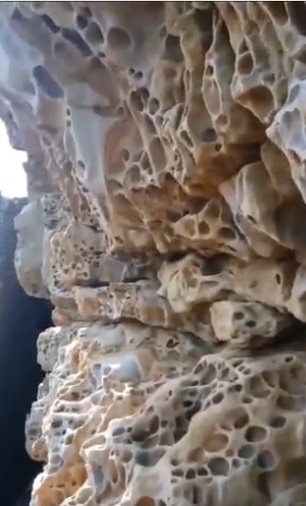
“Cheese Rocks.” Malorechenskoye in Solnechnogorsk, Crimea
Click image for video link
On the coast of Crimea, the village of Malorechenskoye in Solnechnogorsk. Locals call it “Cheese Rocks” .
Its structure is very reminiscent of the spongy inner part of bones.
So if this is part of a bone, imagine how big its owner is.
Titan🧐
|
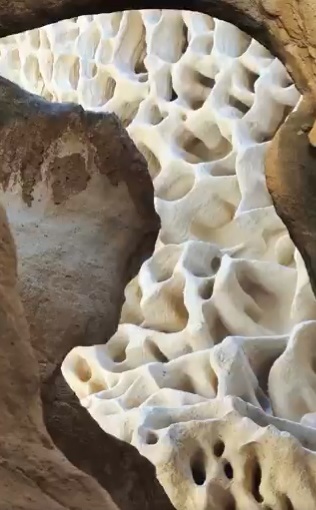
The Open (Ybyk) Canyon, Kabyrga tract in the Mangystau region of Kazakhstan
Click image for video link
The Open Canyon, also known as the Ybyk Canyon, is a formation located in the Kabyrga tract in the Mangystau region of Kazakhstan.
Natural Formations, they says.
|
Update: 25th July 2025 | So, I decided to check my decision that the moon rocks and following videos of “Cheese Rocks” reveal the inner spongy part of bone. So I asked @Grok, “I have been looking at scanning electron microscopy images to find what bones looks like. What other body parts gives a slightly thicker looking but similar spongy look? Are there thicker levels of sponginess based on what creature is being looked at?” Here is the reply @Grok Link
So, based on this reply, I started looking further at scanning electron microscopy images, and I have now decided that these rocks are more likely to be cartilage, rather than bone. According to @Grok, “Cartilage is a flexible, resilient connective tissue found in various parts of the body, serving multiple critical functions due to its unique structure and properties.” So, at this stage, I don’t think this is spongy bone tissue and I am not 100% sure it’s cartilage either! If I find an RS video commenting on any of these rocks. I will place the link here.
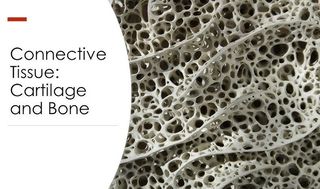
Elastic Cartilage
Click image for link
Cartilage is a flexible, resilient connective tissue found in various parts of the body, serving multiple critical functions due to its unique structure and properties.
Comment: Found this as a thumbnail image for a histology course on YouTube but couldn’t find it on the video.... However, I think this is like elastic and hyaline cartilage SEM images that I have seen.
Basically, in cartilage the holes are smaller and a lot more rounder looking that that of pure bone.
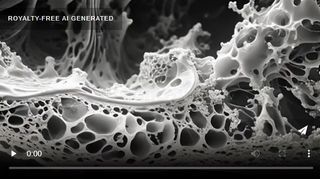
Collagen fibers in cartilage, SEM
Click image for video link
An electron microscope image shows the dense and tightlypacked collagen fibers in cartilage crucial for shock absorption and smooth joint movement. AI generated
|
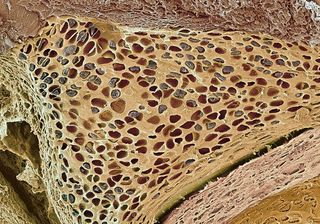
Hyaline cartilage. SEM.
Click image for link
Coloured scanning electron micrograph (SEM) of hyaline cartilage from the spinal column. Hyaline cartilage is a type of connective tissue that consists of an extracellular matrix (yellow) produced by chondrocytes (grey), the only cells found in cartilage. Single chondrocytes reside in lacunae (holes). Hyaline cartilage coats parts of the vertebrae of the spine, reducing friction between the vertebrae and allowing flexibility. Hyaline cartilage is found coating other joints, as well as providing structural support to the nose and trachea (windpipe). Magnification: x70 when printed 10 centimetres wide.
|
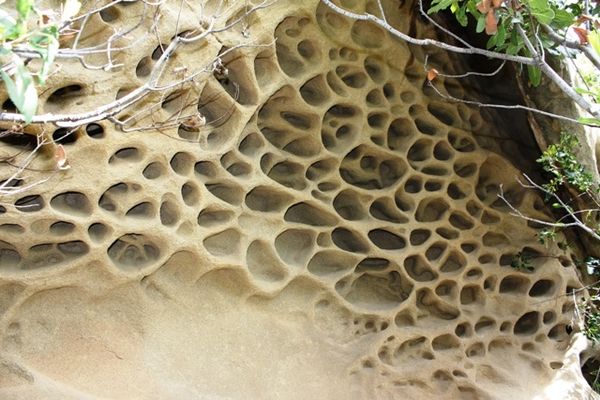
Tafoni Weathered Stone. Pool Rock, San Rafael Mountains, US.
Click image for link
Comment: For whatever reason, these natural rock cavities are called tafoni, a mystery among scholars and scientists as we are informed that nobody can agree on how it develops and grows. Regardless, I am now convinced that these rock cavities are titan cartilage. Moreover, I am coming to the conclusion that anything that is needed to keep things together in the body is much tougher and will survive much better. There are 11 images provided here on this webpage. By the way, one of the examples provided is from Devil’s Playground, Santa Ynez Mountains....

Click image for video link
Tafoni Is Decayed Biology. Overwhelming Evidence.
YouTube, 15 Dec 2024
 This research suggests that earth is not millions of years old. Geological theory on Tafoni is that it is created by Eons of Erosion. I prove its not in this video. Eons of Erosion is Removing it, Not The Cause Of it! Tafoni is Decayed Biology in most cases, some are a membrane which I have shown in my research videos. if an Academic or geologist can’t see this, then a fence post has a higher I.Q. A Bag of hammers has more common sense IMO.
This research suggests that earth is not millions of years old. Geological theory on Tafoni is that it is created by Eons of Erosion. I prove its not in this video. Eons of Erosion is Removing it, Not The Cause Of it! Tafoni is Decayed Biology in most cases, some are a membrane which I have shown in my research videos. if an Academic or geologist can’t see this, then a fence post has a higher I.Q. A Bag of hammers has more common sense IMO.
Comment: Ths is Tyson’s Mudfossil Adventures and there are at least 13 videos on Tafoni. Tyson makes videos of his Mudfossil discoveries.
Gökçeada, (largest island that belongs to Turkey) | Pinterest Link 1
Comment: Pinterest has more examples, but often there is no location details provided and there are a faked images to contend with too.
Eroded rocks on Lemnos, Greece | Pinterest Link
Comment: This Pinterest page leads to more examples, mixed with faked images.
|
The Mystery of Concretion Balls & Their Tendons Solved!
There is a known mystery of giant balls seen lying around all over the planet. The Mudfossil hypothesis has an answer, but it’s like the children’s song, Dem bones, dem bones. Yes, there are a lot of moving parts and because what we see in or on the geological landscape is on such a huge scale, it’s often too difficult to see the connections. Here, the main effort is to explain that any body is held together by tendons under tension, but they are anchored into bone by small cells or balls. This also includes skin as will be briefly explained. The biggest surprised is the how tendons are made up and what they look like on the titanic scale... The following is just an attempt at decoding a great mystery!
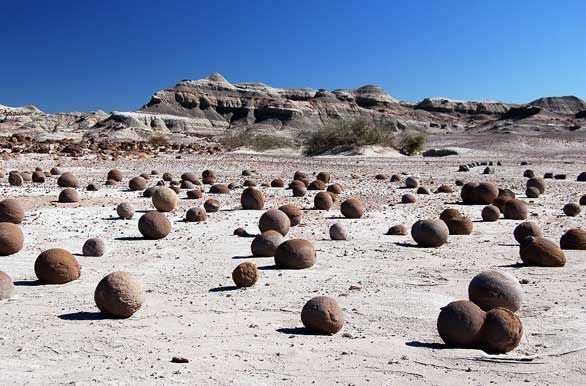
San Juan, Valley of the Moon, Argentina
Click image for link
Comment: Interestingly, The Valley of the Moon is a UNESCO world heritage site. If you look up the landscape here, it is very similar to the painted deserts in the Petrified Forest, Arizona. More Valley of the Moon images on Yandex
Link.
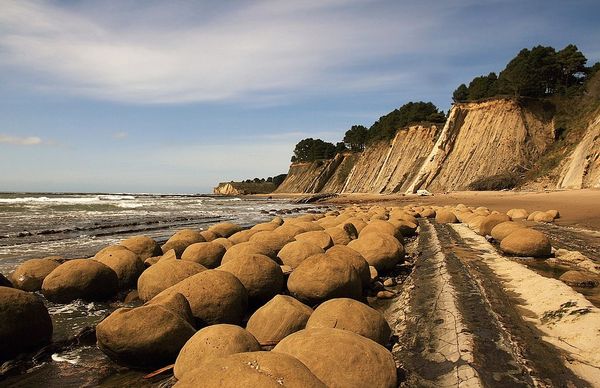
Bowling Balls Beach, Mendocino, California
Click image for link
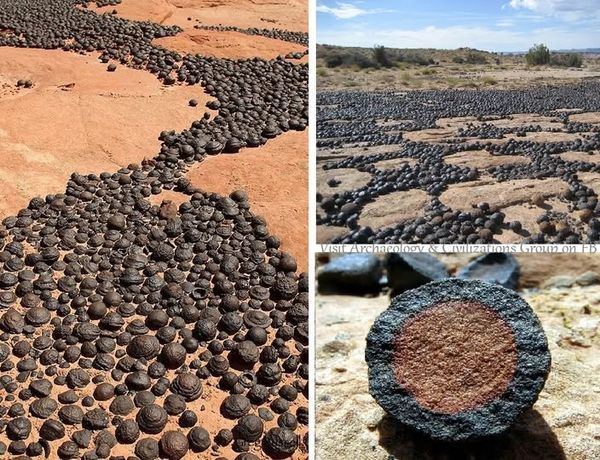
Moqui Marbles, Utah and Arizona.
Click image for link
These stony spheres are concretions — sandstone balls cemented by a hard shell of iron oxide minerals. Often called moqui marbles, acres of the chocolate-colored rocks are scattered across Utah and Arizona. They tumble from the pale, cream-colored Navajo Sandstone beds, when wind and water wash away the softer rock. (Live science)

The Torysh Valley, Mangistau, Kazakhstan.
Click image for link
Giant Fascia Balls to the Walls
YouTube, 5 Jul 2018
Stone balls are examined. They are everywhere and not just on Earth.
Comment: Roger Spurr explains the technicals of how tendons keep the body firmly intact. He also refers to a technical paper that he wrote on this subject matter. Roger still believes NASA about Mars..... Well, I’m not a believer.... The incredible images supposedly from Mars are somewhere on Earth and some people think some of Mars is under the parts of Earth which Google Earth hides under permanent snow, to disguise what is really going on there.... Yes, think about it....
|

Concretions, stuck in the side of a cliff (titan tissue layers).
|
Who can explain these Big Balls
YouTube, 12 May 2022
The world is covered with Stone balls that come in all sizes from tiny to enormous.
Nobody has any idea how they formed so they call them “Concretions” which means they simply made themselves....
Comment: Roger Spurr explains them as tendon balls and as usual he goes into some technical detail. Timestamp
Link
|
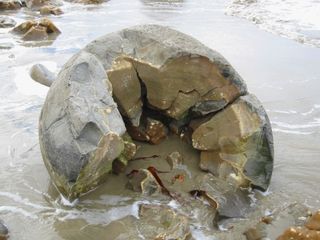
A split concretion. Wikipedia upload.
Click image for link
|
Comment: Another area famous for these stone balls.
|
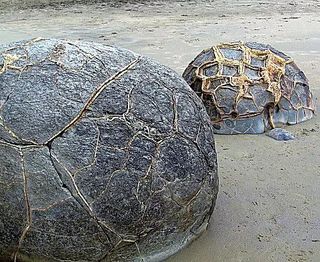
Eroded Concretions at Moeraki, New Zealand
Click image for link
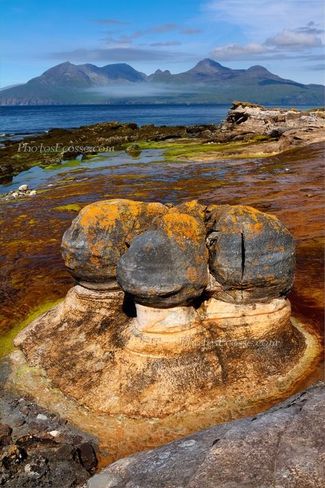
Concretions on stalks?
|
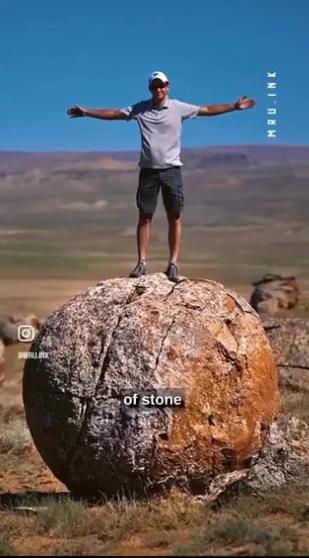
Torysh Valley of Balls, Kazakhstan
Click image for video link
Surreal landscape dotted with thousands of giant stone spheres in Torysh Valley, aka the "Valley of Balls," Kazakhstan.
Formed 40-60 million years ago in the ancient Tethys Ocean, these concretions grew as minerals layered around objects like shells or shark teeth.
Erosion later exposed these natural wonders, ranging from marble-sized to car-sized.
While geologists call them nodules, local legends whisper of giants’ games or petrified enemies. | XTwitter
Link
|
Who can explain these Big Balls
YouTube, 12 May 2022
The world is covered with Stone balls that come in all sizes from tiny to enormous.
Nobody has any idea how they formed so they call them "Concretions" which means they simply made themselves....
Comment: Roger Spurr explains them as tendon balls and as usual he goes into some technical detail. Timestamp
Link
|

A split concretion. Wikipedia upload.
Click image for link
|
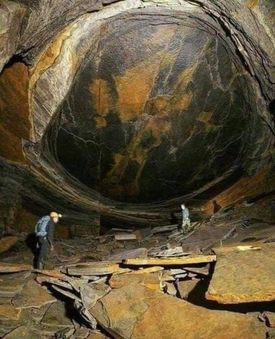 The secret cave half an hour’s drive from Liverpool
The secret cave half an hour’s drive from Liverpool
The potentially dangerous mine shaft in Upholland has been compared to something from the world of JRR Tolkien
LIVERPOOL ECHO, 26 Jun 2021
A cave in a remote corner of West Lancashire has developed a cult status with urban explorers.
Disused mine shaft, known as The Dragon’s Eye cave was a secret shared by a handful of explorers and locals.
Its exact location in Upholland is only known to a few urban explorers who have shared the exact co-ordination points between themselves - and the residents who keep a watchful eye over the area.
Comment: Roger Spurr over at Mudfossil University initially agreed that this was probably a dragon’s eye, but has since changed his mind. Much more likely to be a concretion ball, especially as they are so common. I also totally agree with locals who want to protect this amazing formation.
THE DRAGON’S EYE.. A GIANT SPHERE? -Find The Truth inside the Lancashire Stone Mine-
YouTube, 18 Oct 2019
Giant Stone Balls are a Giant Geological Mystery, lets Re-Examine These Balls with Mudfossil Eyes
YouTube, 26 Jun 2024
Worldwide Big Balls and also little balls Totally Unexplained but Everywhere.
Now they found some in the Ocean and are heavy with metals.
BIG BUSINESS is mining little balls from the sea floor and recovering Rare Earth Metals....Nobody Knows Where they came from or how they developed however I will show you exactly those things.
A Gallery of Concretions
ThoughtCo., August 24, 2017
Key Takeaways
• Concretions are unique formations that come in many shapes and sizes, like spheres or mushrooms.
• Concretions may have interesting inner structures, sometimes resembling fossils or organic shapes.
• Concretions are found worldwide, each with its own special characteristics and formation history.
Comment: This webpage attempts to give some examples and explain what geologists mean by concretions.... It’s quite likely that they are not caused by one process and is a term used to lump any rock that is unexplainable and happens to be spherical in shape.
Yandex search "concretions + beach"
Link
Comment: This is the best way to see a lot of concretions around the world in one go!
|
More geological examples and anatomy for comparison
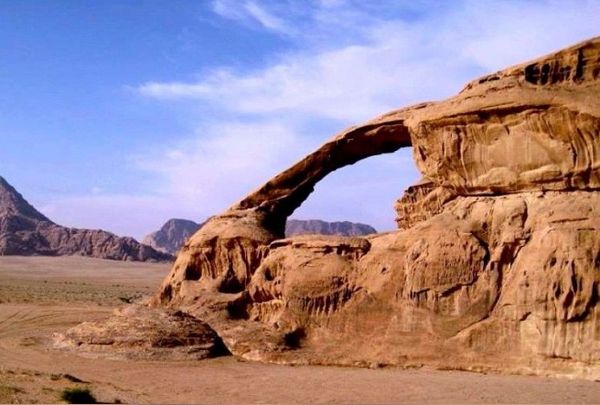
Arch clearly anchored by a huge ball. Arches National Park, Utah.
Arches National Park, Utah
has over 2,000 natural stone arches, in the southern part of Utah’s extended canyon country.
Comment: The real question is: how did these 2,000 arches not erode away over millions of years? Why does this particular arch appeared anchored by a giant ball? Well, if this is the remains of titan flesh, then maybe with a bit more knowledge of anatomy we can work out what is really going on here.
Update: RS explains one of the most famous arches in Arches National Park as being the remains of a titan tendon strap anchored to a huge ball. This is compared to biology with anatomical (SEM) images. ~ 3 minutes Link
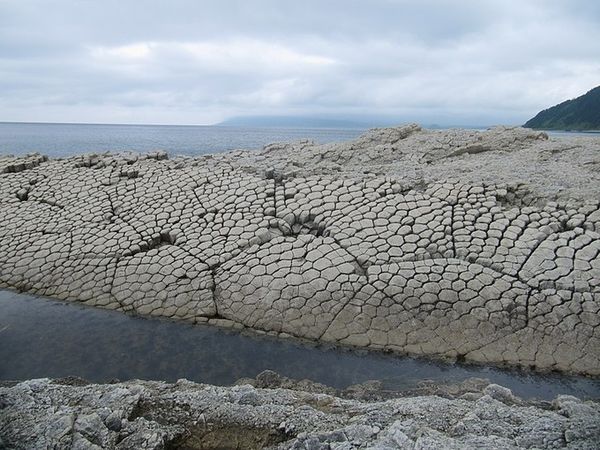
Rock displaying a titan tendon cross-section with hexagonal pattern
Click image for link
Comment: This is a brilliant example of the cross-section of titan tendons.
Note this hexagonal pattern is seen at a large scale around the world. (See the Silicon Tree and Devil’s Tower info). Please note that not all tendons have the same geometry in the body.
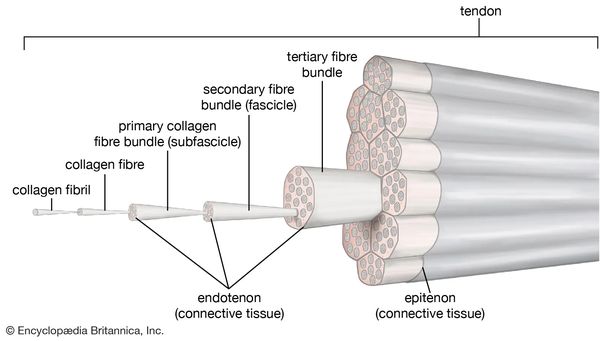
Tendon: tissue that attaches a muscle to other body parts, usually bones.
Click image for link
|
Basalt Column Formation Taught to Kids is Simply Wrong and Actually the Columns are Biology not Lava
YouTube, 16 Mar 2025
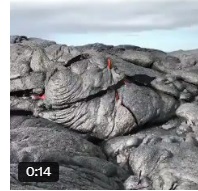
Comment: I think the expert’s opinion was removed from this video (maybe there was a copyright claim). However, we get some concise Mudfossil explanations with scanning electron microscopy and anatomy diagrams juxtaposed with geological examples.
Btw, there have been no examples of volcanic eruptions solidifying into any geometrical shape. The best that can be seen is a lava flow or globules. Click image for video. Also more flowing lava videos here.
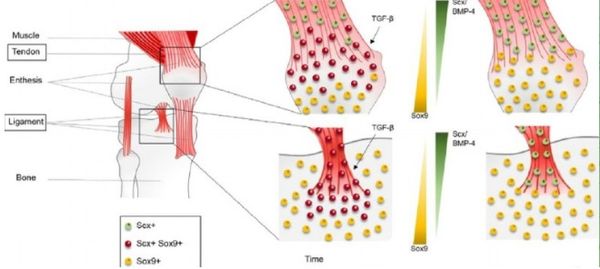
Human anatomy of tendons, muscles, ligaments and bone.
Comment: RS mostly uses this particular tendon+ anatomy drawing to demonstrate that tendons are anchored to bone by tiny balls. Often many anatomy diagrams do not show this level of detail.
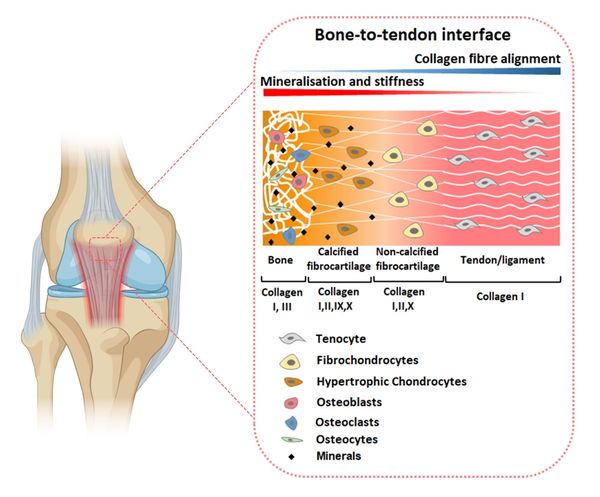
Bone to tendon interface diagram.
Click image for link
Comment: So, I asked @Grok, “What are tenocytes, fibrochondrocytes, hypertrophic chondrocytes, osteoblasts, osteoclasts and osteocytes that exist in the bone to tendon interface.” @Grok replied “The bone-to-tendon interface, often referred to as the enthesis, is a specialized region where tendon connects to bone, facilitating force transmission and structural integrity. Several cell types are involved in this interface, each with distinct roles in development, maintenance, and repair.” Then proceede to give a detailed breakdown. I presume the different types of cells are what are shown as balls in the previous diagram. Grok’s full answer Link
|

Cave of Crystals, Naica Mine, Mexico
Click image for link
Caption Cave of Crystals. Geologist standing in the Cave of Crystals (Cueva de los Cristales) in Naica Mine, Chihuahua, Mexico. The crystals are the largest known in the world, and are formed of the selenite form of gypsum (calcium sulphate). They formed over millions of years in the mineral-rich geothermally heated water that filled the caves. The crystals were discovered after the water was pumped out of the mine. The Cave of Crystals is 290 metres deep, and was discovered in 2000. Above it, 120 metres deep, is the Cave of Swords (Cueva de las Espadas), which was discovered in 1912. The crystals in this cave are smaller as its water cooled more rapidly.
|
Earth is a Corpse and a Body (Material Proof you will see) and it was Written in Ancient Times
YouTube, 8 Apr 2023
Only recently was it understood Earth is BIOLOGY just as was written in the Nag Hammadi texts discovered in 1945. In that text the Living Jesus was recorded by Thomas as saying "The Earth is a Corpse and Body" which is completely obvious now as you will Clearly See.
Comment: The giant crystal caves are the insides of certain types of titan tendon endthesis points. This is an incredible explanation! I hope RS is right!
|

Tendon enthesis anatomy variations
Click image for video link (Timestamp)
This anatomy diagram shows the variations in tendon enthesis points.
|

The Interstitium Lattice
Click image for link
Scientists discovered the new organ, which consists of fluid-filled spaces, in the body’s connective tissue, including in the skin’s dermis, which is shown above as the light pink layer at the bottom of this image.
|
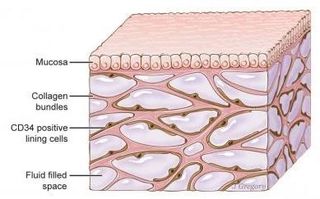
The Interstitium Lattice
Click image for link
An image of the interstitium beneath the top layer of skin. Researchers say the organ is a body-wide network of interconnected, fluid-filled spaces supported by a lattice of strong, flexible proteins.
|
Meet Your Interstitium, A Newfound ‘Organ’
LIVESCIENCE, March 27, 2018
With all that’s known about human anatomy, you wouldn’t expect doctors to discover a new body part in this day and age. But now, researchers say they’ve done just that: They’ve found a network of fluid-filled spaces in tissue that hadn’t been seen before.
These fluid-filled spaces were discovered in connective tissues all over the body, including below the skin’s surface; lining the digestive tract, lungs and urinary systems; and surrounding muscles, according to a new study detailing the findings, published today (March 27) in the journal Scientific Reports.
Comment: Actually, what is of interest here is the attempt to scale up to the titanic scale and understand how the discovery of this lattice and the anchoring system explains what we see left over to form geological anomalies like concretions. So, we are informed that this layer is an elastic lattice that behaves the same way as tendons do with the exact same use of cells acting like anchors. Since these anchor cells are found all over the body, then it might provide a good explanation for why these titan sized anchor cells now exist as concretions.
Skin of the Titans
YouTube, 16 Oct 2019
How thick is a Titans Skin? In Mudfossils that skin can be thicker than the tallest Dinosaur we know of.....
Comment: RS comments on the 2018 article Meet Your Interstitium, A Newfound ‘Organ’.
|
Why are Massive Sinkholes Now EVERYWHERE
YouTube, 29 Apr 2021
Comment: Here RS reveals the Interstitium layer in a recent massive sinkhole that opened up in Turkey. Btw, years ago in my News of the Imbalance blogs, I wrote about how these sink holes looked laser cut..... Nothing has changed in what can be seen occuring.

An Exposed Interstitium layer
Click image for video link (Timestamp)
|
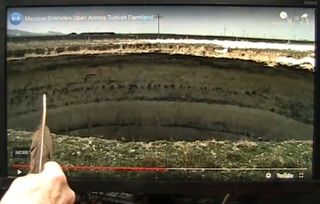
Sinkhole Interstitium layer
Click image for video link
Nucleus Of Interstitium.
YouTube, 5 Mar 2024
Tyson’s Mudfossil Adventures, does a good job explaining that concretions have something inside but Interstitium balls do not have crustaceans or amonites inside. The image adjacent comes from drone footage.
|
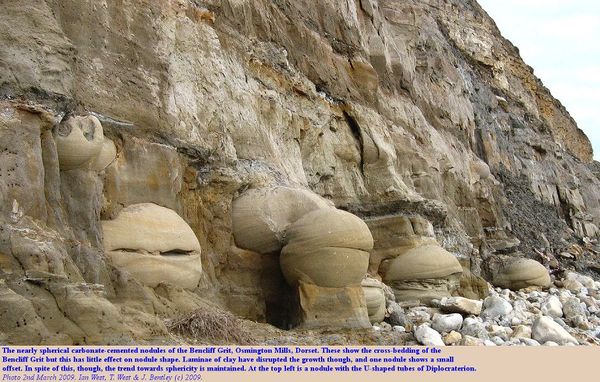
Osmington Mills, Dorset, UK
Click image for video link
Comment: I found this UK webpage using Yandex.com. Incredibly we have some side by side examples of concretions still stuck into tissue layers and still attached to the original tendon/Interstitium lattice which of course is petrified into stone. I don’t think there is any debate because the tendon and ball rock types are clearly completely different to the surrounding clay (epidermis/dermis tissue layer).
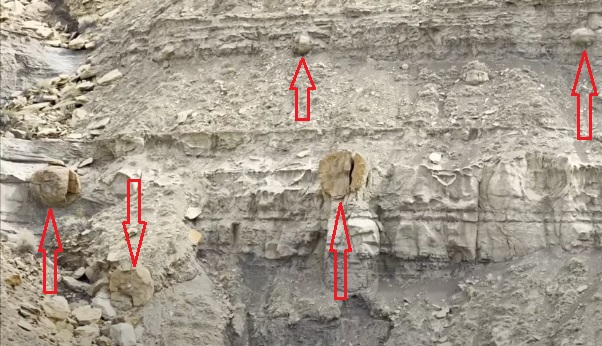
Desert Area Overlooking Monument Valley? USA.
Click image for video link (Timestamp)
Please note: The blogger @thePOVchannel immediately notes the concretion balls stuck in distinct layers in the side of a cliff and states, “strange geology out here.” Well, based on the Mudfossil hypothesis, this is not strange at all and should be expected.
|
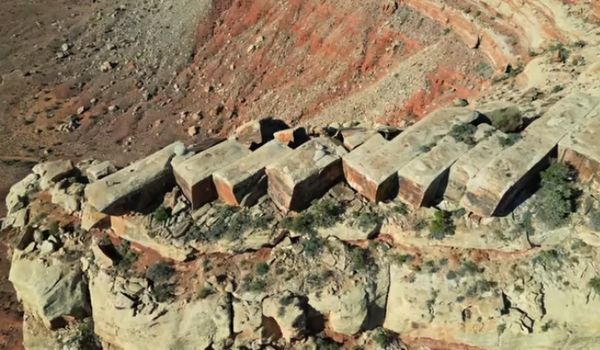
Impossible Rock Formation Found on Google Earth, US.
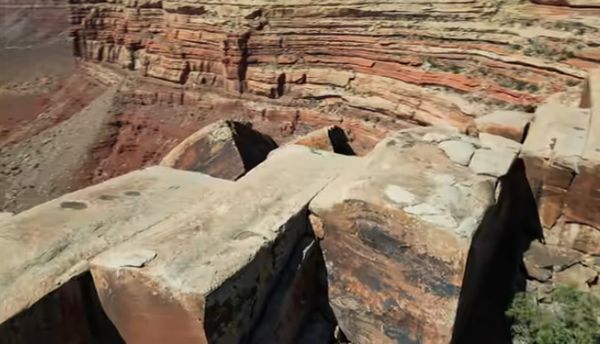
Impossible Rock Formation on Google Earth, US.
Click image for video link
I Found the Most Impossible Rock Formation on Google Earth
YouTube, 31 May 2025
The biggest, strangest thing I have ever found on Google Earth. The angles, views, and history of this place was incredible.
Comment: This is from @thePOVchannel and you have to watch this video to appreciate the vast size of these stone blocks....
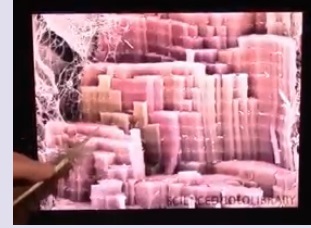 Just to add to the complexity. Not all tendons are the same. RS talks about
aponeurosis (single) or aponeuroses (plural) which is a flattened tendon by which muscle attaches to bone or fascia. “Aponeuroses exhibit an ordered arrangement of collagen fibres, thus attaining high tensile strength in a particular direction while being vulnerable to tensional or shear forces in other directions. They have a shiny, whitish-silvery color, are histologically.” Wikipedia
Just to add to the complexity. Not all tendons are the same. RS talks about
aponeurosis (single) or aponeuroses (plural) which is a flattened tendon by which muscle attaches to bone or fascia. “Aponeuroses exhibit an ordered arrangement of collagen fibres, thus attaining high tensile strength in a particular direction while being vulnerable to tensional or shear forces in other directions. They have a shiny, whitish-silvery color, are histologically.” Wikipedia
On the titanic scale they appear as huge blocks lined up together and when the original tension has gone, they break up into a zig-zag pattern.
This video is another good example of why you need to look around to see what else is showing. The background looks fleshy to me. I think this video is the latest in a series in this area. See 24th May 2025 drone footage Return to Impossible Geometry: A Massive, New Discovery
Click image right for Mudfossil video link.
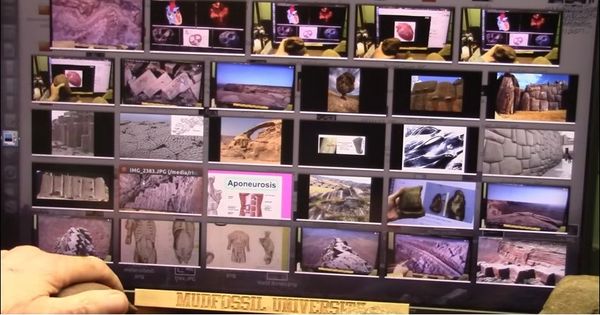
Click image for video link
Can Any Geologist Please Explain how these Truly Stunning Fabulous Rock Formations were Created
YouTube, 15 Feb 2024
There are unexplained Geological Formations all over the world but there is now a reasonable explanation as you will see.
Click image for video link
Comment: Here RS starts his presentation by commenting on a @thePOVchannel video. The @thePOVchannel blogger does incredible and popular videos of his geology visits and adventures which occur only after he finds an interesting location using Google Earth. In this instance, RS provides more of a big picture overview when explaining what can be seen in the @thePOVchannel video. (Roger tends to repeat stuff so there may be other similar videos. Also @thePOVchannel blogger protects the locations he finds and will go back to re-investigate the “impossible“” geometry so that causes some confusion picking out his videos.
Anyway, Roger goes on to explain that decomposition conditions will determine what happens to titan tendon/ball remains. So, either the tissue erodes and the balls are left over. Or the balls erode and the tissue is left over. How decomposition occurs depends on chemistry. Factors include; how long left in water, temperature, saltiness, and how much silicate is in the mixture. (Presumably that is why the Arches National Park in Utah is so unusual, because it seems that we have some clear examples where we can see the petrified tendon still attached to it’s petrified stone ball anchor.) Timestamped link.
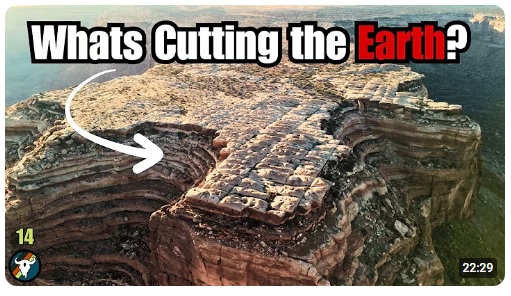
Click image for video link
I Found IMPOSSIBLE Geometry While Flying My Drone!
YouTube, 19 Jul 2025
While exploring the remote deserts of the American Southwest in search of Ancient Puebloan history, my drone discovered a Geological formation that defies explanation.
Flying my drone over a rugged cliff near Monument Valley, I discovered a geological formation so precise it seemed impossible—giant earth blocks and geometric shapes carved into the land. At first glance, they defy all logic. Are these the result of intelligent design? A rare geological process? Or is there something stranger happening here?
Comment: This Impossible Geometry can be found overlooking Goosenecks State Park, Utah. I think it is fair to suggest that the Gooseneck circular arcs and those indicated in this thumbnail image, are caused by ancient mining. In terms of the geology found here, the massive surface blocks and the exposed layers are pure biology.
Explanation of Monument Valley Petroglyphs and Landscape and Your Comments are Very Welcome
YouTube, 1 Aug 2025
Comment: RS gives his opinion that the blocks are titan aponeurosis tendons and the exposed cliffs are pure titan tissue layers. I think what’s impossble is how conventional geology could give a reasonable explanation for what can be found at this location.
Spotted Lakes and Other Titan Organs
Since there are a lot of geological anomalies, it takes a lot of time to research. So due to time constraints, this section will be short. I am still researching blood red lakes that are considered a permanent feature not caused by a sudden overnight occurrence. In the Mudffossil hypothesis, there is another more bloody explanation and that is leaking arteries or even hearts. It’s as if the organs are still alive.... Anyway, I asked @Grok for a list of major and minor organs in the body, but I did not want the list to be longer than 20 items.
X marks the few examples that have been covered here:
X Brain - Controls nervous system, thoughts, and bodily functions.
X Heart - Pumps blood, supplying oxygen and nutrients.
X Lungs - Facilitate oxygen intake and carbon dioxide expulsion.
Liver - Detoxifies, metabolizes nutrients, and produces bile.
X Kidneys - Filter blood, regulate fluids, and produce urine.
X Stomach - Digests food and breaks it down with acids.
X Small Intestine - Absorbs nutrients from digested food.
X Large Intestine - Absorbs water and forms waste.
Pancreas - Regulates blood sugar and aids digestion.
Spleen - Filters blood and supports immune function.
Gallbladder - Stores and releases bile for fat digestion.
Bladder - Stores and expels urine.
X Skin - Protects body, regulates temperature, and senses touch.
Thyroid Gland - Regulates metabolism via hormone production.
Adrenal Glands - Produce stress and metabolism hormones.
Esophagus - Transports food to the stomach.
Diaphragm - Muscle aiding breathing.
Pituitary Gland - Controls other glands and growth hormones.
Ovaries/Testes - Produce reproductive cells and hormones.
Appendix - Minor role in immunity, stores gut bacteria.
@Grok conversation
Link
#Lungs
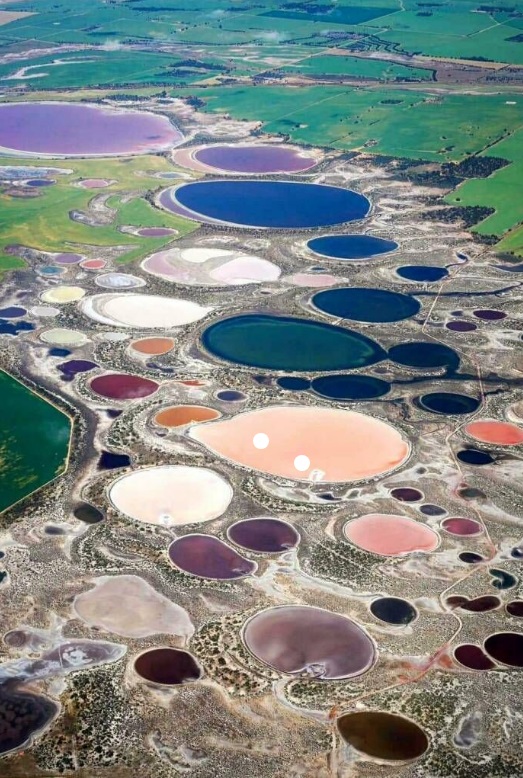
Unknown salt lakes in Western Australia
Click image for link
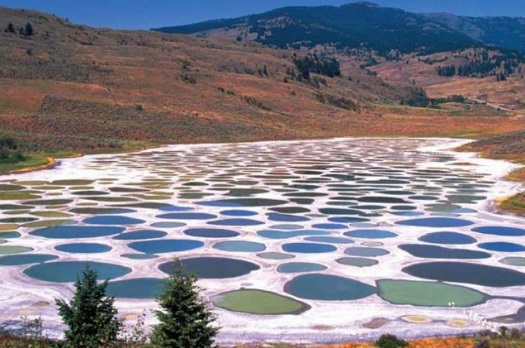
Spotted Lake, Northwest of Osoyoos, British Columbia, Canada.
Click image for link
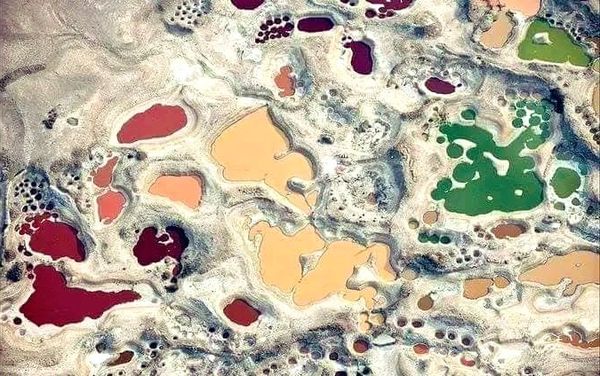
Spotted Lake, Magado Crater in Kenya
Click image for link
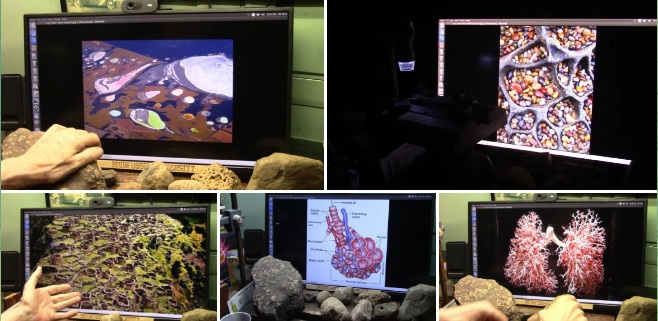
Click image for link
What Events Caused This “Bloody” Exceptional Preservation of Prehistoric Creatures and this Heart? [1:35:31]
YouTube, 16th Jul 2024
It is now well known that Geology is Biology turned hard and many are Giant Creatures called Mudfossils. The Preservation is flawless and soft tissues were invaded by silica rich particles that created stable “Rocks” but were indeed creatures once.
The variety of body parts and the conditions and colors and chemistry is stunning and some are very colorful...others still full of blood like this Heart.
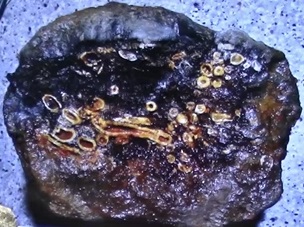
Hightlight Timestamps
[19:31] RS shows a lung that has been preserved really well Link
[27:41] RS talks about transition metals Link
42:15 Back to lung info Link
45:08 Spotted Lakes Link
[48:43] Lung Artery anatomy? Link
[1:06:08] A small lung under a microscope Link
Comment: Roger Spurr does cover a few topics (meander) here. Of interest, is the discussion on the Spotted Lakes and the comparison with lungs. The different colours are associated with different tissue chemistry (enzymes, molecules etc). Different colours correspond to different charges on different transition metals. Even within an organ like a lung, in death some kind of stabilisation will occur that requires different ingredients i.e different transition metals. Crystal silicates bond and form crystals. The final outcome varies due to a variety of factors like temperature and the amount of silicate available etc.
Yellowstone National Park
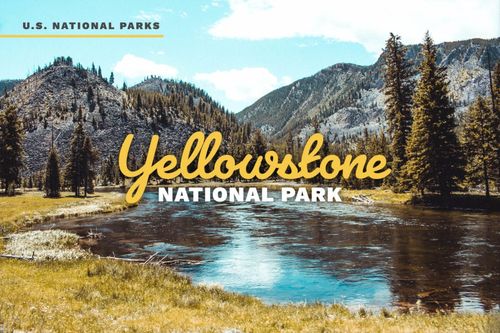
Click image for link

Click image for link
2nd August 2025 | In July 2025, there was a lot of concern due to reports of many different animals leaving Yellowstone National Park. This is likely to be evidence that the animals have been told by their guidance system to evacuate.... Here are some short videos on XTwitter Link 1 & Link 2. Moreover, there have also been recent mainstream reports of large hydrothermal explosions in recent years, Link. Furthermore, social media is reporting strange geothermal activity at Yellowstone Link.
Scientists have been busy trying to understand the geology, but despite efforts they admit they are flummoxed. The idea of a supereruption is to explain the existence of volcanic deposits or ash over tens of thousands of square kilometers, see Biggest Ever Yellowstone Eruption Revealed.
Interestingly, the Delores Cannon The Convoluted Universe book series highlights previous civilisations where experimentation had gone wrong and caused major catastrophes. In one instance, the majority of humans were burnt and left as “charred bodies.” I now believe that geologists with their super volcano theory erupting over tens or hundreds of thousands of years, is just another fairytale for adults to hide the truth.
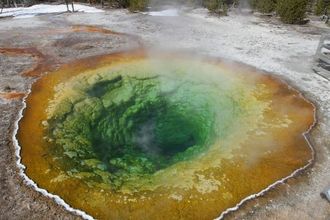
Morning Glory Pool. Yellowstone National Park.
Click image for link
Yellowstone National Park , USA: A Geological Wonder Documentary [2:50]
YouTube, 26 Mar 2023
Yellowstone National Park, one of the world’s most spectacular natural wonders. Covering nearly 3,500 square miles, this incredible landscape is home to some of the most geologically active features on Earth, including hot springs, geysers, mud pots, and fumaroles.
|
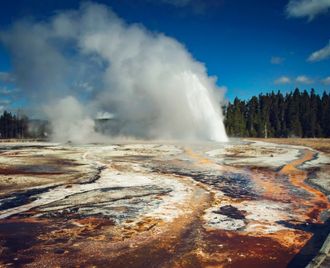
Daisy Geyser erupting in Upper Geyser Basin. Yellowstone National Park
Click image for link
Old Faithful & Upper Geyser Basin - Yellowstone National Park
Flying Dawn Marie, February 28, 2022
Comment: A collection of great high resolution photos.
|

Grand Prismatic Spring in Yellowstone National Park.
Click image for link
Major Yellowstone Eruption. Disaster area mapped Link
Comment: Mute sound.
|
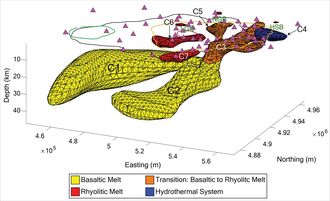
Schematic showing magma storage beneath Yellowstone caldera.
Click image for link
Comment: Use link for full details.
An Electromagnetic View of How Magma is Stored beneath Yellowstone
U.S. Geological Survey, January 13, 2025
|
Yellowstone is a Buried Creatures Body Organs...its Lungs are Yellow and Buried Blood is Volcanic
YouTube, 14 May 2025
This Info is from a recent Survey of deep Under Yellowstone. I will detail exactly what you see and why and the chemistry anatomy and much more.
You will Clearly see my Claims are TRUE....This is From AI about my work.
“Roger Spurr’s Mudfossil theory proposes that many geological formations, including mountains and rock structures, are actually the fossilized remains of enormous living creatures. If this theory were true, it would necessitate a radical revision of our understanding of history and geology.”
Comment: Roger Spurr was thrilled to discover the latest survey via magnetotelluric imaging to map the magma beneath Yellowstone. He immediately realised that what was found could be used to outline his beliefs that everything is biological. RS states that the different rock types equate to different organs of a titan creature that was buried. He identifies the respiratory system with 2 lungs and two halves of a heart separated by the ventrical wall, the thyroid and a trachea (throat) that acts as the valve system that leads to the hot springs on the surface. The stomach can be found 20 - 50km deep as a deeper magma storage area.... To fully understand the RS analysis on Yellowstone National Park, will probably require some high level education.
Using custom earthquakes to define the top of
yellowstone’s magma reservoir
USGS, April 28, 2025
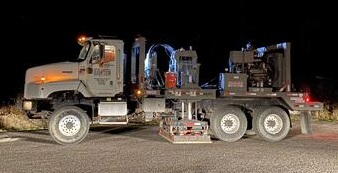
New research used artificial earthquakes generated by a truck with a vibrating hydraulic plate to better understand the depth and characteristics of the top of the magma chamber beneath Yellowstone caldera.
Comment: So back in September 2020, USGS used a 53,000-pound vibroseis truck, with a hydraulic vibration plate to hammer the ground at Yellowstone, in order to generate seismic signals that can be used to map underlying terrain. In my opinion, the timing was highly suspicious with a scamdemic in full swing......... Fortunately, nothing happened then, but nearly five years later, something is now happening......
#Hearts
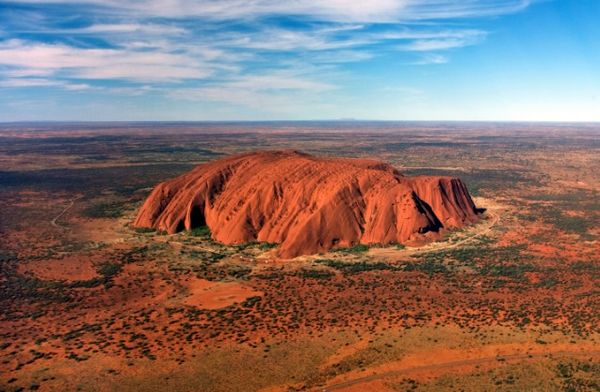
Uluru (Ayers Rock), Northern Territory, Australia.
Click image for link
The Uluru, also known as Ayers Rock, is a large sandstone rock formation located in the southern part of the Northern Territory in Australia.
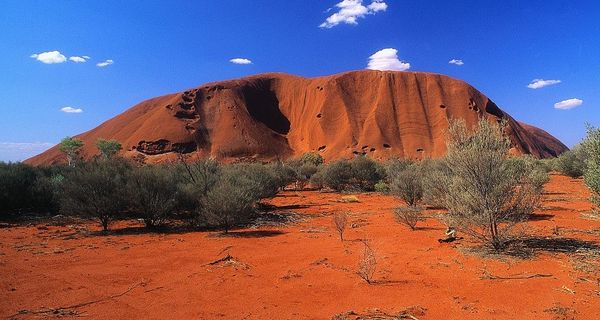
Uluru (Ayers Rock), Northern Territory, Australia.
Click image for hot link large image
Comment: This image gives a better view of all the “holes” and other key features.
|
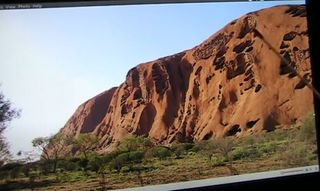
Uluru (Ayers Rock) close-up, NT, Australia.
Click image for video link (timestamp)
Ayers Rock is Sacred Heart
YouTube, 18 Dec 2018
Ayers Rock....Uluru...what can it be... how was it formed?
Its a bloody heart mate..... The details are unimpeachable and shown here now.
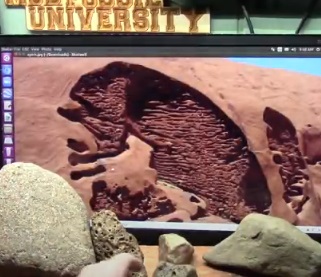
Heart muscle tissue turned to rock.
Uluru (Ayers Rock), Northern Territory, Australia.
Click image for video link
Comment: What’s that hiding under the cover? RS explains many anomalous features that can be found at Uluru (Ayers Rock).
|
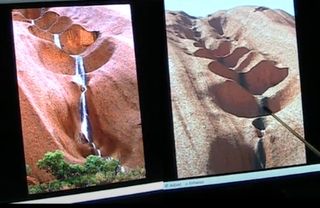
Uluru (Ayers Rock) close-up, NT, Australia.
Click image for video link (timestamp)
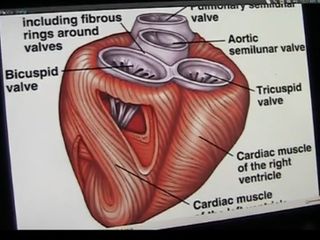
Heart Anatomy
Click image for video link
Ayers Rock the Heart of the Matter
YouTube, 18 Feb 2022
Uluru is a very sacred place in Australia. Mudfossil research indicates it was biological and the evidence is presented here. Maybe it is time to reflect on our past?
Comment: Well, I have found someone who claims Ayers Rock is an ancient mining slag heap that has turned to concrete.... Ancient Australian mining
The problem with that belief is that there is no real scientific discussion of the features that can be seen.... It’s not even in the classical cone shape of a slag heap.... At least RS can put up some heart anatomy and make some comparisons...
|
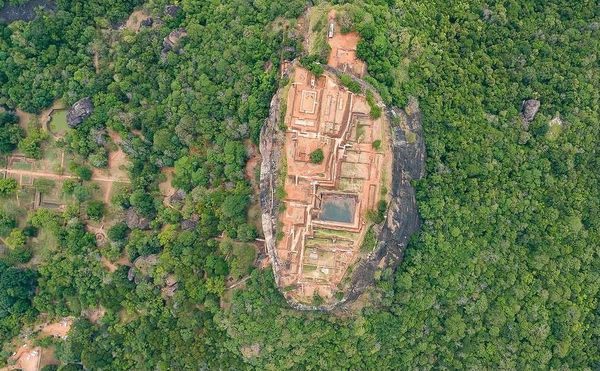
Sigiriya (Lion Rock), Sri Lanka.
Click image for link
A birds’ eye view of Sigiriya shows the fortress and some surrounding gardens.
Comment: See other Lion Rock images in Part 1. #LionRock
|
You Can get Blood from a Stone
YouTube, 26 Feb 2022
Many rocks still have blood in them. I have 3 DNA tested as Human mtDNA and some cat scanned and chemistry is Ferrous Oxides...we call them oxidation states of blood.
Mudfossils changed everything in Geology...and I mean 100%.
Comment: RS starts talking about Lion Rock at ~ [1:25].
RS says Lion Rock is a heart and it does seem quite similar to Uluru (Ayers rock). However, I was not convinced until I reviewed more images and saw the image adjacent, where the holes for the heart valves can be quite clearly seen.
|
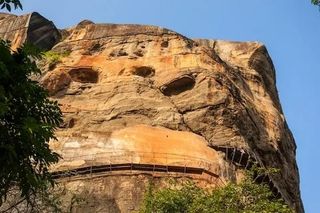
Sigiriya (Lion Rock), Sri Lanka.
Click image for hot link
Comment: This image was found using Yandex.com. The image had been removed from the webpage, but preserved by Yandex.
|
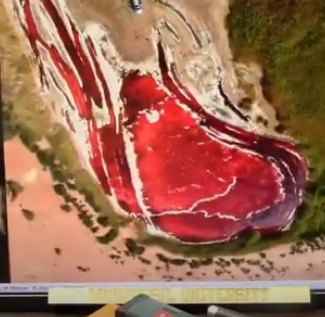
Click image for video link
I Claim this is a Giant Heart but How Could a Giant Heart Still have very Red Blood in It
YouTube, 7 Jun 2023
Anyone unfamiliar with my Research will scoff at my claim made here now. The Thumbnail is a Heart in Libya and red blood still hydrates. The muscles are well articulated.
Comment: I think the image sent to RS was faked, because I am struggling with the idea that this heart would have been found in such good condition even if it maybe a huge crystal..... So, even if it was unearthed due to road construction?, I would still like to see more images to verify authenticity. Whatever, RS points out a van on top of the cliff where the heart is on display.... Whatever, I think the commentary about the details of the heart is some basic education. Nevertheless, I will look out on the internet to prove that this image is not faked.
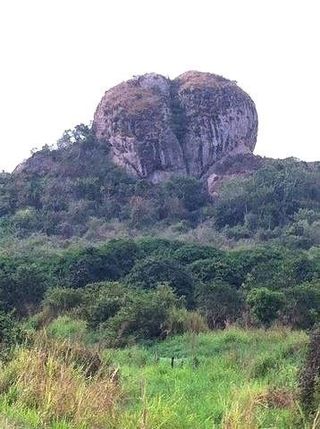
Click image for link
You Cannot Imagine What This Really is But You Will See Clearly
YouTube, 28 Jun 2025
Myron just did a vid and asking about a Series of strange “Geological” formations that he is curious about as was I. As a fellow researcher I respectfully ask Myron to engage with my Claims that point to possible biology. As you will see my claims are pretty well supported by Material Evidence not “possible theories”.
Comment: RS likes to respond to other people’s videos. It’s very interesting that well known gelogists find geological features that they have no answers for, but RS does.... Seriously, the biology angle seems to give plenty of answers.... Btw, there is a feature on Myron’s video called The Devil’s Punch Bowl.... It’s just ridiculous!
|
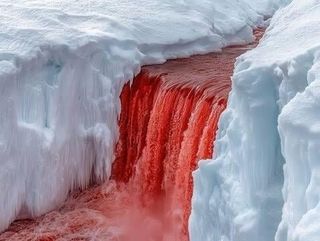
The ‘Blood falls’ in Antarctica.
Click image for link
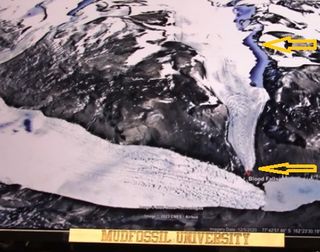
Blue ‘Blood falls’ in Antarctica.
Click image for link
Top arrow: Blue ‘Blood falls’ falls
Bottom arrow: Red ‘Blood falls’
Comment: And nobody talks about the blue blood, accept for Roger Spurr....
Blood Falls Revisited and Shocking
YouTube, 5 Mar 2023
The study of the Earth and rocks and geological processes has changed recently. So much of our earths crust is unexplained and Blood Falls is a prime example of what has been missed.
Comment: RS has done many videos on ‘Blood falls’ in Antarctica. This video is ~ 4 minutes and concise. RS points out the bright blue (de-oxygenated) blood as well as the red blood.... Yes, just like from a real heart.... The source was a titan creature that must have been very well preserved under the ice.
Heart Stones Galore!
YouTube, 30 Jun 2025
Throwback to my first interview with Sean from SGT Report. Nearly six years ago.
Comment: Timestamped. This is a short clip from an SGT Report interview ~ 4 minutes. The rock hearts in Roger Spurr’s collection are from 1cm - 45cm.
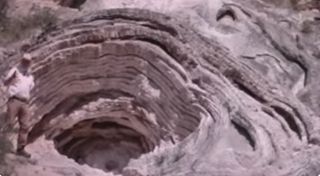
Click image for video link
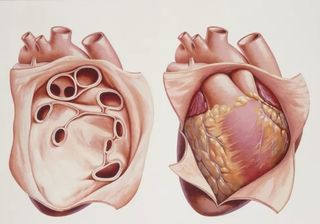
Heart Valves Anatomy
Click image for link
|

A Geological Anomaly. Found at Grand Staircase Escalante National monument.
Click image for link

Click image for video link
A blogger on Facebook found an almost pure white rock sandwiching a purple rock layer.
Geological Anomalies Examined ... the Series Mudfossils pt1
YouTube, 2 Dec 2023
Comment: RS randomly selected this strange geological anomaly from a selection of 50 or more unexplained formations, source description here Link. After some examination, RS thinks the dark red/purple is a tube and states he believes its a major artery that was in the heart of a good sized creature.
|

Click image for video link
Comment: So, based on the Mudfossil expertise of Roger Spurr, is this dark red/purple stone from a petrified giant creature’s artery blood? Here’s two more videos where the contents of the cut rock is bright blood red Link 1 & Link 2.
An artery is a blood vessel in humans and most other animals that takes oxygenated blood away from the heart in the systemic circulation to one or more parts of the body, see Wikipedia for exceptions and more information Link
|
#Brain
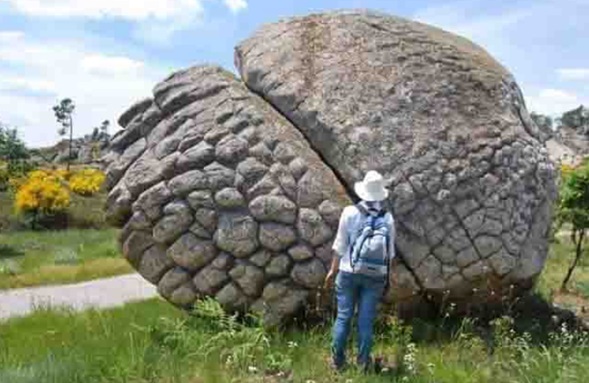
Click image for hot link
Comment: I found this image on a Russian webpage discussing Polygonal masonry. Well, obviously it’s a brain!
Right: Petrified Brain found in Neanderthal Valley. Near Mönchengladbach, Germany.
|

Click image for link
|
Use your Brain or it will turn to Stone
YouTube, 1 Feb 2022
Mudfossil Giants are everywhere and its time to sort out the meaning. We cannot run and hide....in this world ignorance is actually bliss but in the next who can say?
Will todays refusal to be truthful impact the next round? From what I read in the ancient texts this is a test...best to study just in case.
Comment: Here RS discusses this giant petrified brain in this 2 minute video. Still searching for the image of the eye-side of this brain.
#Kidney
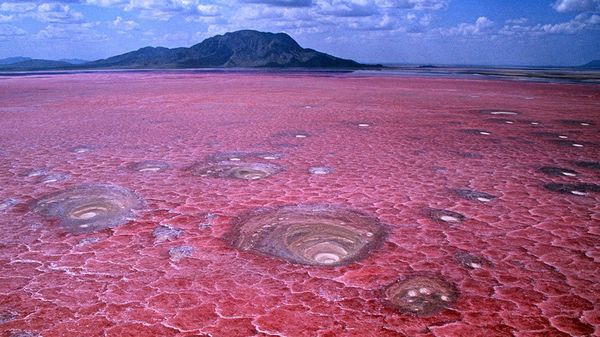
Lake Natron, Tanzania
Click image for video link
Does Lake Natron really turn animals to stone
YouTube, 15 Feb 2018
Stranger than you can imagine my friends.
Comment: This is incredible. Lake Natron is a petrifying lake.... RS explains how he realised that Lake Natron is a product of a functioning kidney. It is filled with Natrium salt which removes water, just like the function of a kidney.
Google Earth reveals that there is something that is kidney shaped right next to the Lake (I checked this too, see below), but RS says that there is/was leaking directly into the Lake that is causing the damage. The blood red colour takes us back to the question: what exactly is blood? I need to do more research there, as RS talks as if the Titan organs are still alive and I am not sure. Quite frankly, Blood Falls in Antartica is making me think really hard! Kidney anatomy timestamp here.
.
The Digestive System: The Stomach, Small & Large Intestine
In mid September 2025, someone dropped two astounding cave images in my social media timeline of what immediately realised were parts of the digestive system of a Titan. Eventually, I found the location in Spain, with reports and video of this amazing discovery. The images were from inside of a cave that had only been discovered in the last two decades and where great care had been made to restrict access and to monitor those affects on the cave's fragile ecosystem. Therefore, instead of basic anatomy diagrams and SEM images which are often AI generated, all of a sudden, the detail provided was overwhelming. The following is an attempt to compare the macro with the micro and to come to some conclusions. I had started to have some doubts about what Stone Forests were all about, especially after I found out about Fairy Chimneys. I realise that high levels of expertise are required but finding relevant information is just hard work. Nevertheless, these discoveries are only strengthening my belief that the Mudfossil hypothesis and related sources are correct.
#Stomach
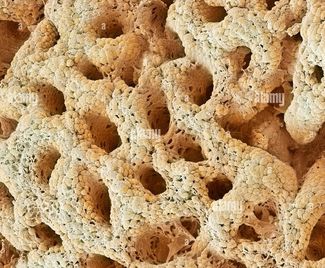
Stomach lining.
Click image for link
Stomach lining. Coloured scanning electron micrograph (SEM) of the inner lining of the stomach (gastric mucosa). The indents are gastric pits.
|
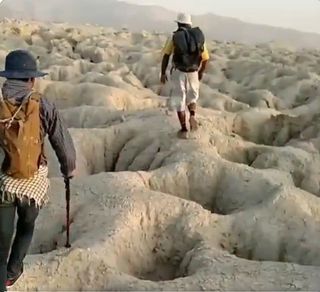
Remnants of a mud flood or the skin of a titan? Pakistan.
Click image for video link
Comment: Based on my study of stomach linings, I think these hikers are walking on the surface of titan sized stomach lining or as we say in the UK, they're walking on tripe! They are all being very careful not to fall into the gastric pits!
|
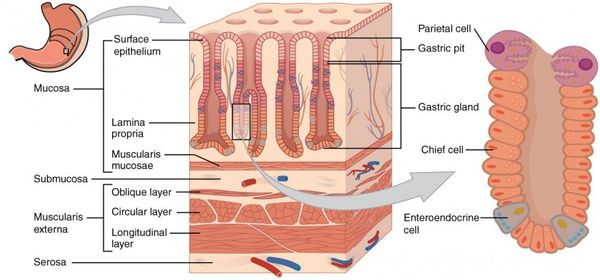
The Stomach Wall
Click image for link
The stomach wall is adapted for the functions of the stomach. In the epithelium, gastric pits lead to gastric glands that secrete gastric juice. The gastric glands (one gland is shown enlarged on the right) contain different types of cells that secrete a variety of enzymes, including hydrochloride acid, which activates the protein-digesting enzyme pepsin.
Comment: The scanning electron micrograph (SEM) diagram image appears to be a much better tool to make titan comparisons, rather than the 2-dimensional stomach lining anatomy diagrams.
|

Click image for link
Please note: The large intestine and the colon are essentially the same. The large intestine is the final section of the digestive tract, and the colon is its largest part, responsible for absorbing water and forming stool. The terms are often used interchangeably, though the large intestine technically includes the colon, cecum, rectum, and anal canal.
|
Comment: Apparently, there are 40,000 caves in Turkey, so finding more details and images might be a problem. However, I believe this is the stomach guts of a titan! Update: This may NOT be a cave in Turkey, but still searching. See below:
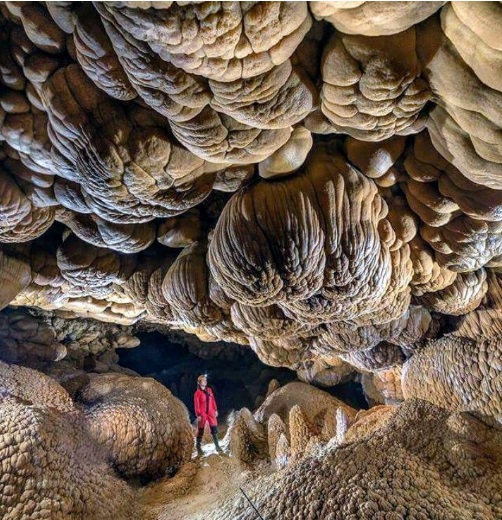
The Sima de la Higuera (Pliego, Murcia region), Spain
Click image for link
Comment: This is also known as the Fig Tree Cave.
Sima de la Higuera. Natural Monument of the Region of Murcia (Spain)
YouTube, 30 Oct 2020
Recently declared a Natural Monument of the Region of Murcia, the Sima de la Higuera is located within the town of Pliego. With a known depth of over 5,500 meters, it is the largest known underground complex in the region. Inside, we can appreciate a wide variety of elements and formations of great aesthetic impact, unique in the world.
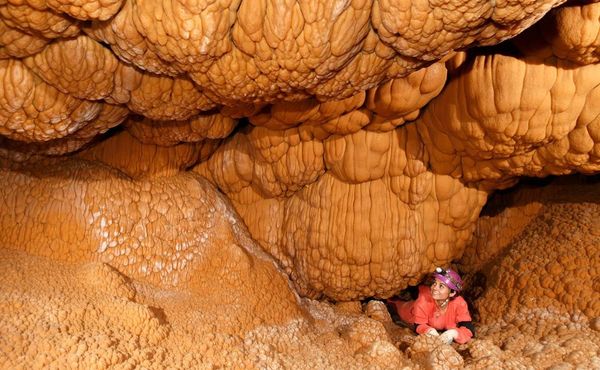
The Sima de la Higuera (Pliego, Murcia region), Spain
Click image for link
My six hours in the Sima de la Higuera
This is what I saw when I explored the beautiful Pliego Cave, the third Natural Monument in the Region, almost ten years ago.
LA VERDAD, November 5, 2020
In March 2011, I descended into the Sima de la Higuera, the impressive Pliego Cave, which has just been declared a Natural Monument by the Government Council.
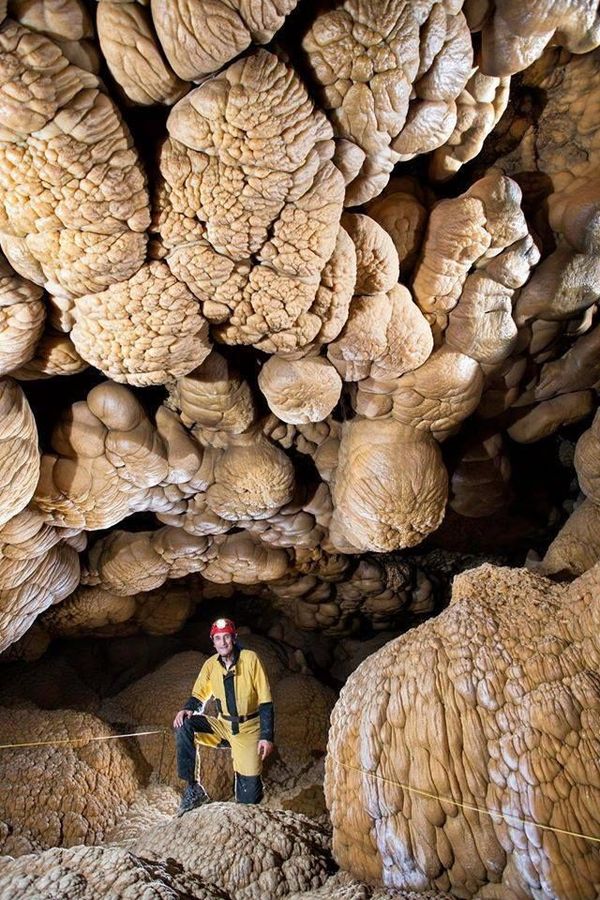
The Sima de la Higuera (Pliego, Murcia region), Spain
Click image for link
Sima de La Higuera (Pliego) | Wikipedia
Link
Comment: I believe this is the stomach guts of a titan! Wikipedis has 77 images in the in category “Sima de La Higuera (Pliego)”. Some of these images are astounding close-ups of titan biology.
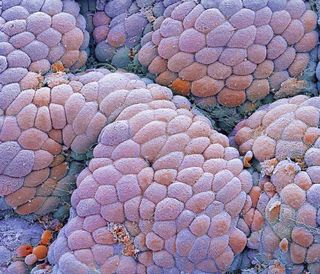
Stomach lining, SEM.
Click image for link
Coloured scanning electron micrograph (SEM) of the lining of the stomach, known as the mucosa. The stomach is a muscular sac involved in storage and digestion of food. The surface of the mucosa consists of simple columnar cells that secrete mucous. The mucous protects the stomach lining from digestive acids and enzymes that act on food in the stomach. Magnification: x1600, when printed 10 centimetres wide.
Comment: So, even though SEM images are helpful (AI generated?), these titan carcass remains can be so detailed, that the known science has to be reconsidered.
|
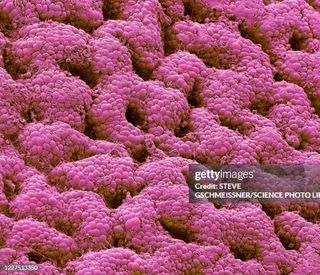
Stomach lining, SEM
Click image for link
Coloured scanning electron micrograph (SEM) of the glandular lining (mucosa) of the stomach. The gastric mucosa secretes the digestive enzymes and hydrochloric acid. This surface epithelium of simple columnar cells secretes mucus, while the gastric glands are the pits seen in this epithelium. From these pits digestive enzymes are produced. Thousands of these glands line the stomach wall. On the larger scale, the stomach mechanically churns food around, while on this scale, gastric juices act to chemically break down the food. This thick lining and large amounts of mucus protect the stomach from these digestive processes.Magnification: x800 when printed at 10cm wide.
|
#Small/Large Intestine
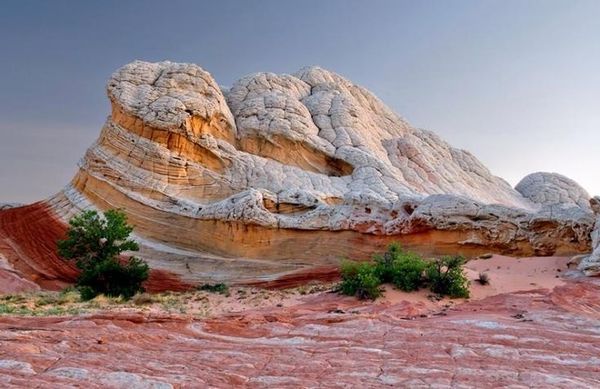
White Pocket, Arizona
Click image for link
Comment: There is a lot of evidence here that this was some kind of Titan carcass. Roger Spurr believes that the skin is rather a membrane or stomach lining. | Twitter video Link
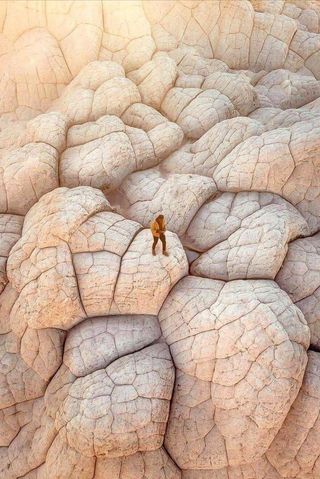
White Pocket, Vermillion Cliffs National Monument near the Arizona / Utah border.
Click image for link
|
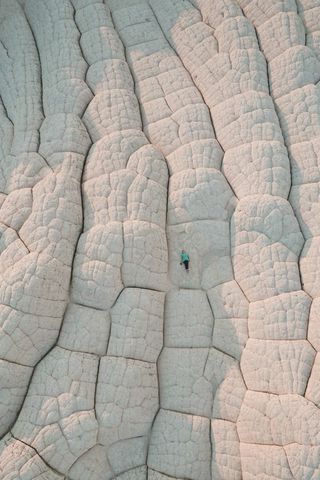
White Pocket, Vermillion Cliffs National Monument near the Arizona / Utah border.
Click image for link
|
Can a Geologist Explain How These Rock Formations Came To Look Like the Inside of a Stomach
YouTube, 26 May 2025
Everyone wants to know how these amazing formations occur and there are few credible answers until now. The Standard answer is Magma but as you will see this is not from Volcanism...
Comment: RS explaining what can be seen at White Pocket using a giant sized book of human anatomy. Timestamp link provided here (~3 minutes).
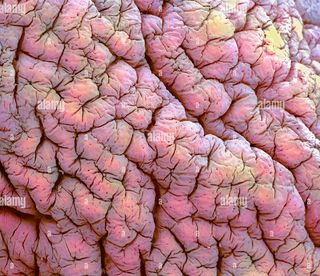
Large intestine.
Click image for link
Coloured scanning electron micrograph (SEM) of the mucosa (lining) of the colon, showing numerous tubular glands (creases) and goblet.
Comment: Confirmed! People are walking up and down a petrified large intestine. Fabulous!
|
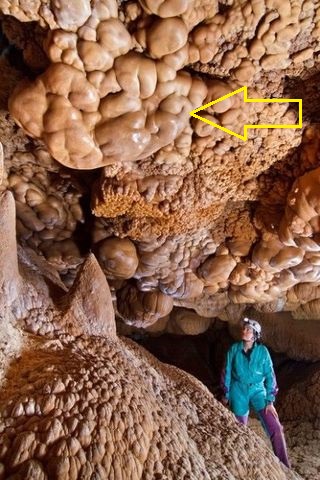
The Sima de la Higuera (Pliego, Murcia region), Spain
Click image for link
Comment: The yellow arrow is clearly pointing to some large intestine. Hi-resolution image available at this website.
|
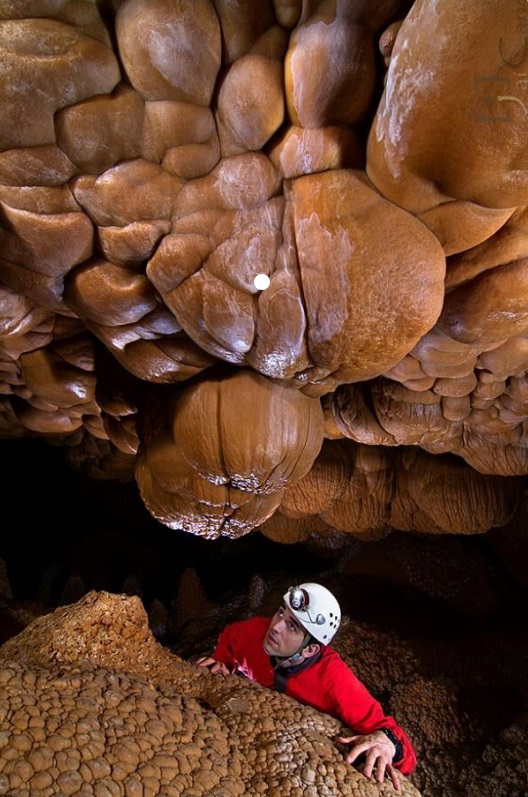
The Sima de la Higuera (Pliego, Murcia region), Spain
Click image for link
Comment: There is a lot going on in the digestive system. Since there seems to be a distinct change of smoothness here, maybe this is small/large intestine. This is only based on comparison with humans and I could be wrong Link 1 &
Link 2
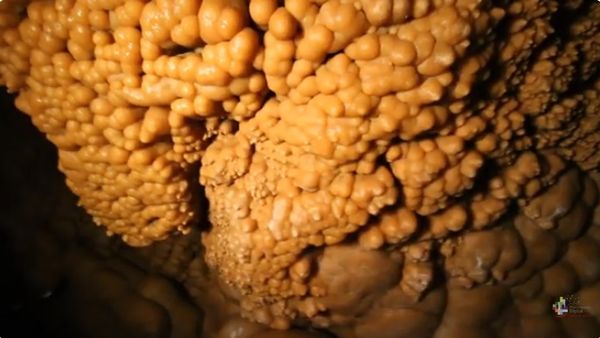
Small Intestine microvilli at birth?
Click image for link
Seriously, an expert needs to have the final say, look at this! Link
|

The Sima de la Higuera (Pliego, Murcia region), Spain
Click image for link
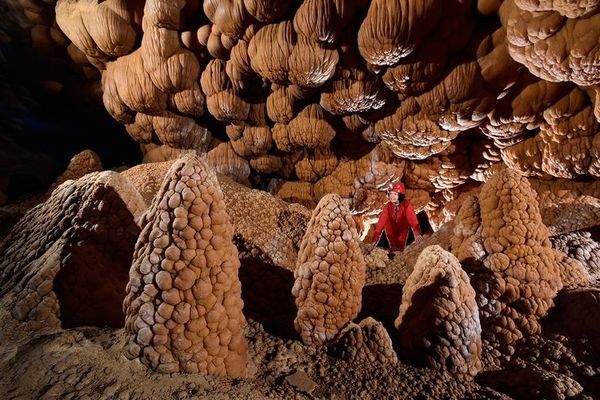
The Sima de la Higuera (Pliego, Murcia region), Spain
Click image for link
Comment: Stalagmites are defined a mound or tapering column rising from the floor of a cave, formed of calcium salts deposited by dripping water and often uniting with a stalactite. However, the patterns seen here cannot re-produced by dripping water.

Inside view of the small intestine.
Villi are tiny, finger-like projections in the small intestine, key for nutrient absorption.
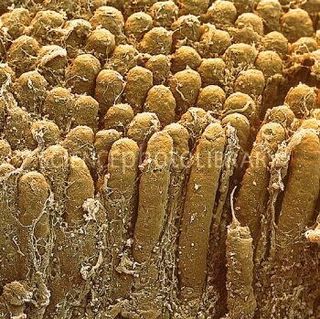
Intestinal villi, SEM
Click image for link
|
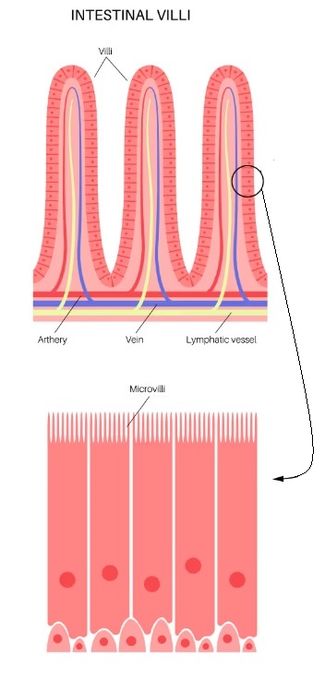
Intestinal Villi Anatomy
Click image for link
|

Villi of the small intestine
Click image for link
|
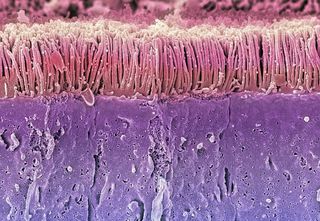
Intestinal microvilli, SEM
Click image for link
Coloured scanning electron micrograph (SEM) of a section through the lining of the small intestine, showing the densely packed microvilli (hair-like, top). These tiny structures form a dense brush-like covering on the absorptive surfaces of the cells lining the small intestine. The cells absorb nutrients from digested food through the microvilli. Magnification: x8000, when printed 10 centimetres wide.
|

Intestinal villi geode
Click image for video link
Comment: I am thinking this is the type of villi found in the jejunum (part of the small intestine). Here is a Getty image for comparison Link.
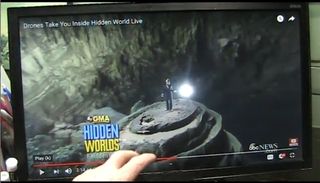
Click image for video link
Comment: Please note that in Titan carcasses, intestinal villi can be enormous. Here a news reporter is standing on a sawn off and sculptured villi. It is acting as an impromptu stage with a ramp for access! Timestamp Link.
Mudfossil Intestines and Cave Update
YouTube, 12 Feb 2019
Comment: The timestamp starts the video at the drone footage of eroding titan intestines. Next RS shows an intestinal villi video (same as above right) and then discusses the adjacent intestinal villi geode.
|

Intestinal Micovilli
Click image for video link (Timestamp)
Comment: There are many similar AI generated videos available on the internet.
According to @Grok, villi and microvilli are primarily found in the small intestine. However, microvilli can also be found in the proximal convoluted tubule of the kidneys and in the respiratory tract, particularly in the nasal cavity and trachea Link.

Fairy chimneys. Cappadocia, Turkey.
Click image for video link (Timestamp)
A fairy chimney is a natural rock spire, also known as a hoodoo, found in regions like Cappadocia, Turkey.
Comment: Please note these fairy chimneys do vary in shape, so it is likely they are mudfossils generated by different parts of a creature's body. The above and adjacent images are taken from a very short segment in the RS video Source of the Nile is Stiil a Mystery for 3000 yrs.
|
Titan Guts Litter the Land
YouTube, 5 Jul 2018
Another mystery seems to be bio-geology just like all the rest. Spikes and spires and huge forests of stone monoliths are Titans and Giants and now I offer the proof and process.
Comment: So after spending a long time doing my own research, I find an old video where Roger Spurr also suggests that we are looking at Titan guts. However, in his anatomy diagrams, the rectum looks similar to the small intestines.
The Geological Chop Shop (Bits & Pieces)
It’s becoming more apparent that as far as geology is concerned, the scientific method was done away with by academia a very long time ago by. Here, I can cite my own experience at University being told to ignore any data points that does not fit the straight line relationship being sought. At the time, I realised that there was a possibility that the irregular or erratic measurements could be the correct ones.... It’s the same as fobbing people off with explanations that geological formations took millions of years, regardless of how far fetched that seems. Therefore, geologists today have to contend with a huge smorgasboard of incredible geological anomalies, easily found on the internet.
The following is just a sample of additional data points that highlight explanations that make total sense with the Mudfossil hypothesis. Btw, I have realised that I love the brightly coloured landscapes. So, I will not be providing images of small rocks, instead I will provide timestamp links to Roger Spurr, who loves his Mudfossil rock samples!
Eyes On This!

Bouddi National Park, New South Wales, Australia
Click image for link
Comment: The famous Bouddi National Park tessallated pavement can be seen bottom left, but surely that is an eye next to it?

The Eye of the Sahara
Click image for link
The Richat Structure is sometimes referred to as the ‘Eye of the Sahara.’
It is approx. 50km across and was only discovered in 1965, when it was supposedly viewed from space. Scientists believe the Richat Structure is a natural phenomenon.
Atlantis is the Eye of the Sahara and Appears Clearly Biological as You Will See
YouTube, 26 Apr 2025
Comment: RS talk about this geological mystery. He is convinced this is a titan eyeball. I am not 100% sure and certainly I don’t think this is the only location for the fabled Atlantis. DYOR.

Click image for link
The Pugachevsky mud volcano resembles a human eye
When Russian photographer, Mikhail Mikhailov took a helicopter ride in eastern Russia, he was surprised to look down and see what appeared to be a gigantic human eye looking right back at him. This was the Pugachevskiy mud volcano, located on Sakhalin Island.
Comment: Someone noted here; why is the eye crying? Will update when more info found.

The Eye of Dragon Madeleine, Dragons Loop, Montana Megaliths
Click image for link
Comment: Is this an eye?

Eyeball found in unknown location
Click image for video link
Giant Mudfossil Eyeball analyzed
YouTube, 4 Oct 2018
Fabulous discovery by a Mudfossil University Associate that has discoveries that exceed this and ignored by the “experts”.

Eye Anatomy
Click image for video link
|

Eye anatomy
Click image for link
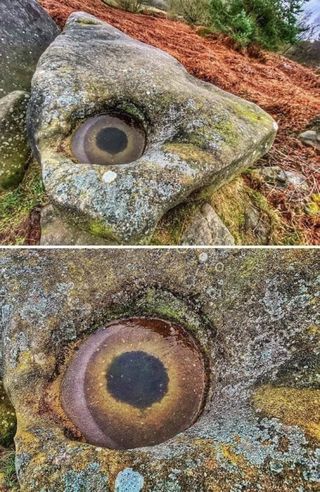
Giant Eye Found In A Rock? Stanton Moor Edge, near Birchover, UK
Click image for link
Comment: It certainly looks like an eye, but probaby not from a dragon.
|
Female Bits

A remote canyon on Google Earth
Click image for video link

Cove Stacks at The Wave, North Coyote Buttes, Arizona.
Click image for link
Comment: Well, the hi res images here are certainly very interesting.....
|

A remote canyon on Google Earth
Click image for video link
Boobs on the Water ...... Fire in the Skies
YouTube, 18 Feb 2024
My research into Mudfossils from the Great Hot Water Flood that cooked and preserved bodies of Giants and other creatures....
Comment: RS comments on a @thePOVchannel blogger video, dated 18 Feb 2024 I discovered Geologic Anatomy visible from Space (Google Earth). This video is also well worth watching.... RS thinks that this blogger is starting to see the biology.
Anyway, RS explains the existence of these fake boobs.... He shows the anatomy of breast tissue and then reveals that the images sent to him are actually concretion balls that have lost their straps, see adjacent images.
|

The Wave, North Coyote Buttes, Arizona.
Click image for video link (Timestamp)
Comment: The image above reveal the petrified (mud fossil) remains of Titan female breasts (presumably from a pregnant titan creature, see more images from this area). RS shows the location of female breast tissue, the sternum and layers of connective tissue that can be seen in the image above. More amazing images from “The Wave” can be found at a Daily Mail article here.

Click image for video link (Timestamp)
Keeping A Breast on the New Geology that is GeoBiology
YouTube, 30 Oct 2022
Comment: This is another short RS video segment where he mentions female breast anatomy and has used the same image for the video thumbnail.
|

The Utroba “Womb” Cave In Bulgaria
Click image for link
Comment: The official explanation obviously refuses to acknowledge the possibility that this is a female titan’s womb entrance with all the anatomy correct. There are 7 very good images here.
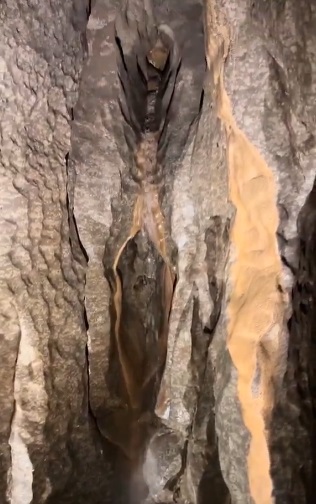
Marble Arch Caves, Northern Ireland
Click image for link
|
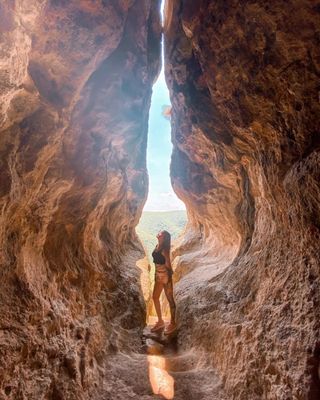
The Utroba “Womb” Cave In Bulgaria
Click image for link
Archaeologists believe that the cave and altar were used by the Thracians. There are several Thracian sanctuaries found in Bulgaria. They believe that it was used as a fertility shrine for the Thracians. The “cult” places of the Thracians are usually located at the top of mountains and they have running water. There is also constantly flowing water at the Utroba Cave, which flows from the cave to the foothills.

Click image for video link (Timestamp)
Boobs on the Water ...... Fire in the Skies
YouTube, 18 Feb 2024
Comment: RS also discusses the technical details of these womb caves, to prove they are anatomically correct.
|
Lots of Bloody Bits

Like a Garden it is polished moss agate from Indonesia.
Click image for link
Skin of the Titans
YouTube, 3 Nov 2018
Amazing Geologist on FB posted this fabulous pic of Moss Agate.
Mudfossil EYES are needed to understand these things.
Comment: Strangely, Roger Spurr uses the above image to start talking about titan skin. Often talks about the role of blood, but here he talks about how much moss and lichen thrive on blood. Since this video is only 5 minutes, Roger does not go off topic that much.



The Wadi Rum desert in Jordan
Click image for link
Where The Martian Was Filmed. One of the Most Amazing Places on Earth
Travelask.ru, 2015
As strange as it may sound, everyone has seen this place, but, alas, only a few have been here.
“Star Wars” , “Transformers” , “Prometheus” and most recently “The Martian” are the most famous of the dozens of films that have been shot here. The interest of filmmakers in the Wadi Rum desert in Jordan is not accidental - it is such a fantastically beautiful place that at some moments you even doubt that you are on our planet. The crazy color of the sand, sky and mountains, the amazing textures of the rocks, gorges and canyons, the incredible Martian landscapes ... where else could “The Martian” have been filmed?
I can say without exaggeration that Wadi Rum is one of the most beautiful places on Earth, and everyone should definitely see it not only in the movies, but with their own eyes.
Comment: A desert drenched in blood. Still there are even deciduous trees growing.
There are 23 fabulous photos on this Russian webpage.


Tadrart Rouge. Algeria
Click image for link

Tadrart Rouge. Algeria
Click image for hot link
Tadrart Rouge (meaning “Red Tadrart”) is a mountain range in southeastern Algeria, part of the Algerian Desert. It is the closest place you can find on Earth that NASA wants you to believe is like Mars. Video XTwitter Link

A narrow Canyon. Tadrart Rouge, Algerian Desert.
Click image for link
Comment: If you look, you will find many more places on Earth where we have to assume were at one time drenched in blood.
Space to Roam: ‘The Red Planet’ Film
andrewstuder.com
Mars is a place on earth… ‘Space to Roam: The Red Planet’ features an astronaut exploring the surreal martian landscapes of the Algerian Sahara as a tribute to the wonders of the planet we call home. While working on this film, the boundaries between Earth and the Red Planet became blurred, leaving me with a profound appreciation for the beauty of both. I hope you walk away with a similar feeling.
Comment: There is some stunning video and photos here.

Red Dirt Waterfall. Waimea Canyon, Hawaii.
Click image for link
Comment: Parts of the waterfall remind me of Uluru. Starting to wonder if this is another titan Mudfossil heart.... YouTube
Kauai’s Hidden Gem: The Red Dirt Waterfall in Waimea Canyon
Comment: The Australian interior is just one big bloody titan graveyard. Obviously, there are variations. Many articles refer to The Red Centre. According to @Grok this is primarily located in the Simpson Desert. This region, known for its striking red sand dunes and arid landscapes, encompasses parts of the Northern Territory, South Australia, and Queensland, with the Red Centre often associated with iconic landmarks like Uluru and Alice Springs Link.
This is the reason why an image of Simpson Desert was used as the background for this graphic Link.
Graphic sources are listed as follows: •Australia Deserts map Link
• Little Sandy Desert
Link
• Babrongan Tower, Great Sandy Desert
Link
• Gibson Desert
Link
• Tanami Desert
Link
• Simpson Desert
Link
• Pedirka Desert
Link
• Sturt Stony Desert
Link & hot link Link 2
• Strzelecki Desert (three weeks after rain).
Link
•Tirari Sturt Stony_Desert
Link & hotlink
•
Link 2
• Great Victoria Desert
Link
Also for info: The Largest Deserts In Australia
Link

Red Ridge. White Pocket in the Vermillion Cliffs.
Click image for link
13th Annual Smithsonian Magazine Photo Contest Natural World
Comment: White Pocket continues to surprise....
|

Red Beach in Hormoz island, Iran
Click image for video link
Heavy rain at the Red Beach in Hormoz island, Iran
Hormuz Island Iran is Gushing Blood at an Alarming Rate
YouTUbe, 14th Feb 2025
[...] Why would an Island Bleed? What have we missed about our Home Planet? How much do Governments know that they do not speak of?
Comment: Of course, RS believes that there is an alternative explanation for the blood red, sand and soil at Hormoz Island. This video takes us on a Google Earth exploration that finds the signature of a HUGE female creature. RS thinks the Red Sea is named after period blood..... The following video dated 20 Jul 2025 is more technical discussion of the types of rocks at Hormoz Island Stunning Layered Salt Tower of Brilliant Colors and Blood Rivers Gush at Hormuz Iran but Why?
|

Black and Red Sand. Hormoz island, Iran
Click image for video link
Comment: According to @Grok, Hormuz Island in Iran has always had red and black sand and red water. We read:
“The black sand, often referred to as “silver” or “glittery” due to its shimmering appearance, contains metal compounds and volcanic materials. These features are a result of the island’s formation as a salt diapir, with ancient salt deposits, sedimentary rocks, and volcanic materials dating back approximately 600 million years, though the island itself has been above water for about 50,000 years. [...] The red soil, locally called “gelack” or “golak,” has been a consistent feature, historically used for artistic, culinary, and industrial purposes, such as in dyes, cosmetics, and ceramics. However, the intensity of the red water can vary, becoming more pronounced during rainfall when runoff carries iron oxide into the sea, creating vivid crimson hues. This effect, sometimes called the “tide of blood,” is not a constant state but occurs periodically, especially during heavy rain.” Link
|

Colorado River Turns Blood Red
Click image for video link
Why did the Colorado Turn Blood Red and Others Turning Red Worldwide
YouTube, 6 Jul 2025
Location: Grand Canyon Region, Colorado River
Date: July 3, 2025
Arizona, USA — In a stunning and eerie natural phenomenon, a stretch of the Colorado River flowing through a rocky canyon has turned an intense blood-red color, drawing concern from scientists, local authorities, and environmental groups.
The dramatic change in the river’s hue was first reported early this morning by hikers and drone photographers exploring the arid desert canyon near the Arizona-Utah border. The scene resembles something out of a surrealist painting: stark brown and gray rock formations flank a glassy crimson river beneath an overcast sky dotted with dense, sweeping clouds. [...]
Comment: Reports of rivers, lakes and even canals turning red and other related colours have been going on for decades. There are many reports on this website, but now we have a possible explanation for why Space Weather or New Energy is waking up the dead titans, see more info in the comments below. Anyway, there was minimum reporting of this Colorado river event outside of social media. Apparently, the Colorado river is the supply source for nearly 40 million people and it is also drying up. Whatever, RS points out the evidence for an enormous giant/titan carcass that he believes is the source of the blood. He eventually states that the river is so red that he thinks the source is a heart that “popped.”

An aerial view of the rust-colored Kutuk River in Gates of the Arctic National Park in Alaska.
Click image for link

An aerial view of the Kutuk River in Alaska’s Gates of the Arctic National Park that looks like
orange paint spilling into the clear blue water.
Click image for link
Rivers in Alaska are turning orange. The reason surprised even scientists
CNN, May 29, 2024
Rivers and streams in Alaska are changing color – from a clean, clear blue to a rusty orange – because of the toxic metals released by thawing permafrost, according to a new study.
The finding surprised researchers from the National Park Service, the University of California at Davis and the US Geological Survey, who conducted tests at 75 locations in the waterways of Alaska’s Brooks Range. The rivers and streams in the range appeared to rust and became cloudy and orange over the past five to 10 years, according to the study published in the journal Communications: Earth & Environment.
|

Click image for link
Alaskan rivers turning orange due to climate change
EHN, May 24, 2024
Climate change is causing Alaska’s rivers to turn orange, posing serious risks to the state’s ecosystems and rural communities.
Anumita Kaur reports for The Washington Post.
In short:
Melting permafrost is releasing sulfide minerals into rivers, causing a chemical reaction that turns the water orange.
These changes threaten aquatic health and could impact rural communities dependent on subsistence fishing.
Researchers identified 75 affected rivers, noting high metal content and acidity in the water.
|

Click image for link
Photographer captures stunning images of ‘rivers of rust’ in Canada
CNN’s Isa Soares speaks with photographer Edward Burtynsky about his exhibit on climate change, which highlights nature’s beauty and our destruction of it.
🔴Alaska’s rivers are turning toxic ORANGE - and experts say it could happen to more water supplies across the world
Daily Mail, 21 May 2024
Comment: Well, due to the scale of the problem, scientists are having a hard time blaming this all on irresponsible mining companies.... Also, yet to find a crib sheet linking colours to titan organs.
|

Click image for video link
Alaska’s Rivers are Bleeding as is Blood Falls Antarctica and even in the Deserts this is Serious
YouTube, 26 May 2024
Comment: RS skips all over the place here, so the timestamp is where he starts properly talking about Alaska. Interestingly, RS uses Google Earth to identify an enormous dragon stretching across the north American continent. RS states blood and other fluids is now escaping from this dragon. Brilliant....
Well, RS believes in global warming, but he also believes the warnings provided by various different ancient texts. I believe the ancient texts refer to cosmic cycles and I think the fabled global warming/climate change is a convenient disguise and distraction. In short, rivers turning red was predicted by ancient texts. In 2004, I realised Space weather was the NASA explanation for the arrival of New Energy, which had been increasing for a few decades, (see my website Space Weather archives). Now, I am starting to think that Roger Spurr’s research is giving me some more answers. Since ancient texts have been adopted and mutilated by priestcraft, I think it is possible to do my own research and join the dots. So, instead of the dead in Christ rising, a more plausible explanation is the promised arrival of Christ Energy on Earth waking up ‘dead’ titans that litter this planet. Somehow, the New Energy is activating titan organs..... Yes, it sounds crazy, but the more I study the Mudfossil hypothesis and see the evidence for myself, the more I think the ancient texts warned about what is happening now. Truly astounding stuff!
|
When Is A Tree Stump Just A Bloody Stump?

Cerro El Pilón, or Pilón de la Purísima. Located in the San Isidro region of Baja California Sur, Mexico.
Click image for link
Comment: According to @Grok:
The volcanic plug in the La Purísima and San Isidro region of Baja California Sur, Mexico, is known as Cerro El Pilón, also referred to as Pilón de la Purísima. This distinctive geological feature, with an elevation of approximately 400 meters, is located between the villages of La Purísima and San Isidro in the Comondú Municipality. It stands out due to its volcanic origin and unique shape, formed as a result of volcanic activity in the Comondú-La Purísima volcanic field, which dates back about 10 million years. The plug, a remnant of hardened magma from an ancient volcanic vent, is a prominent landmark in the area, often associated with local cultural and historical significance, including its symbolic connection to the Virgin María for Jesuit missionaries who founded the Misión La Purísima Concepción de Cadegomó in the 18th century Link
A video that appeared in my XTwitter feed provides another prime example of popular opinion based on faulty beliefs. If you watch this video, it seems that after ~20 seconds, it looks like it was not the same stump. So, was the video spliced with something else? Anyway, geologists state this is a volcanic plug. The alternative general assumption is that this is a tree stump and in Part 1, I gave the opinion of Roger Spurr who stated that Devil’s Tower was a foot. Here, there is evidence of a lot of blood.
|

Cerro El Pilón, or Pilón de la Purísima. Located in the San Isidro region of Baja California Sur, Mexico.
Click image for video link
|
RS states that when the worldwide flood occurred, giants/titans were stuck in the mud. Simply, if the Mudfossil hypothesis is true and that some believed tree stumps are actually titan feet, then surely these remains would be found in pairs? Anyway, at this stage, I don’t believe the cited video (first 20 seconds), reveals a silicon era tree stump. From the ground looking up, this could be a tibia bone snapped off near the ankle joint and surrounded by mudfossil muscle and tendon debris.
🔴 Cerro El Pilón Google Map video Link
Comment: 18 seconds of drone footage from the base of the tendon enthesis point verifying the blood.

Click image for link
|
|